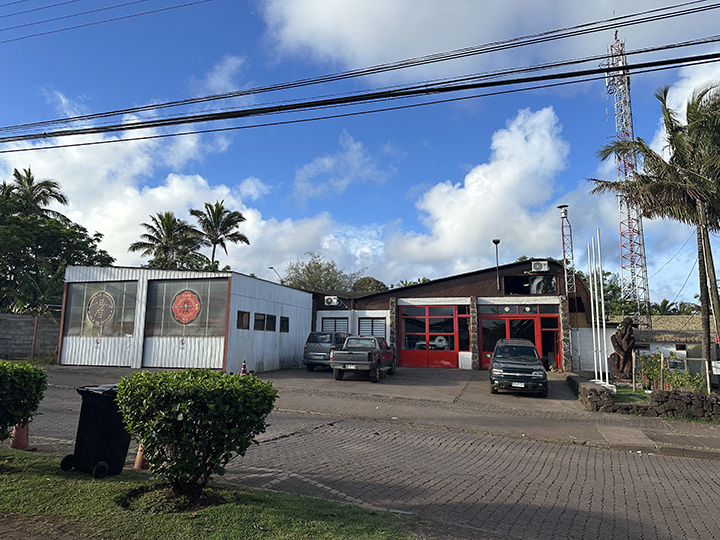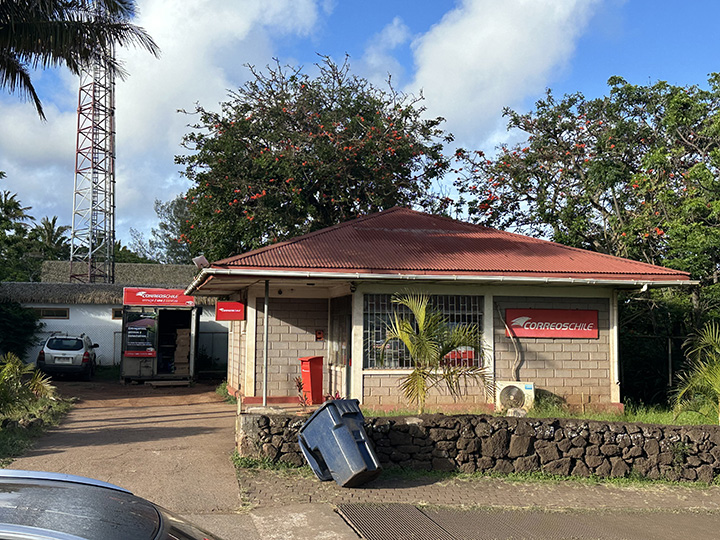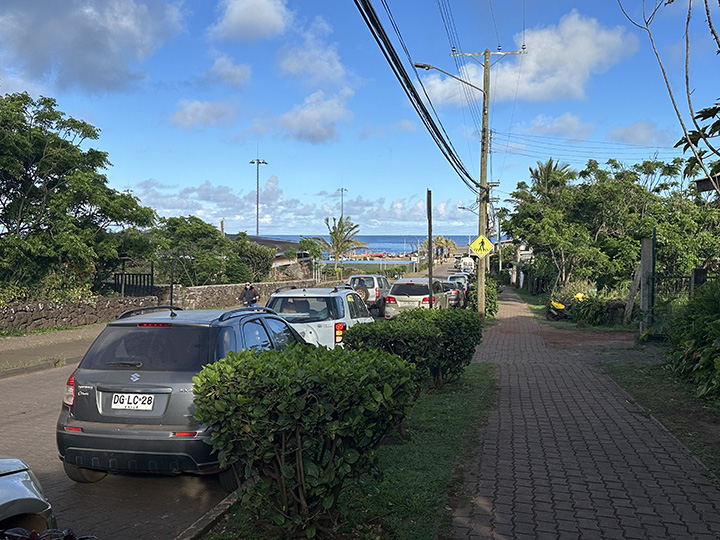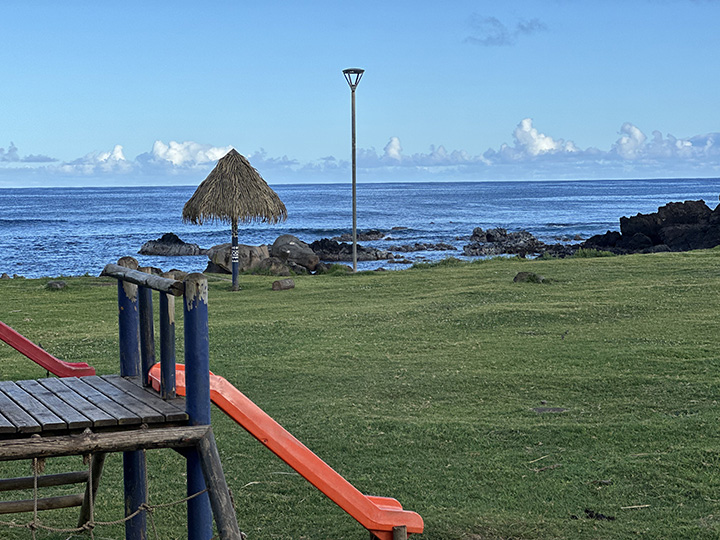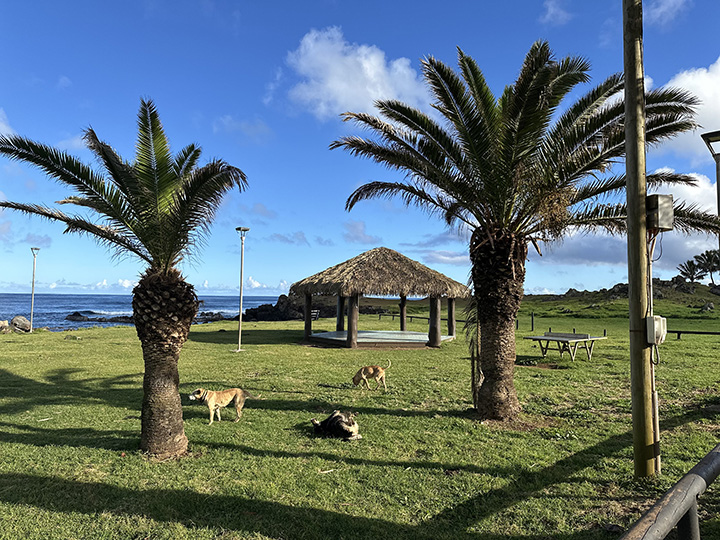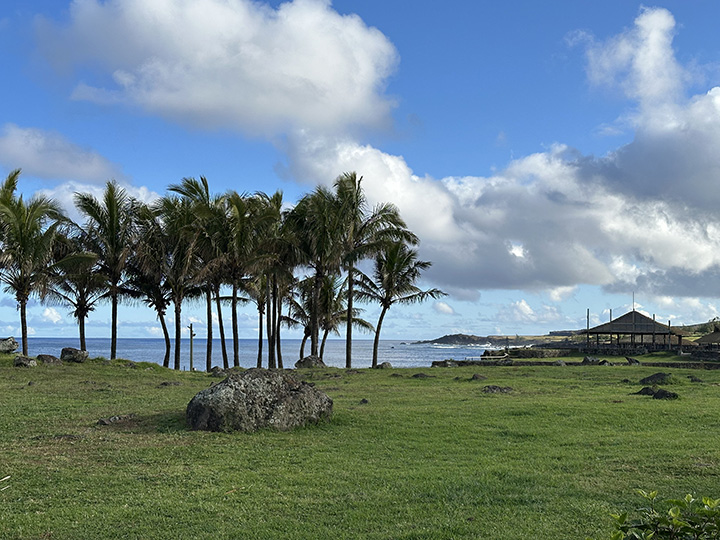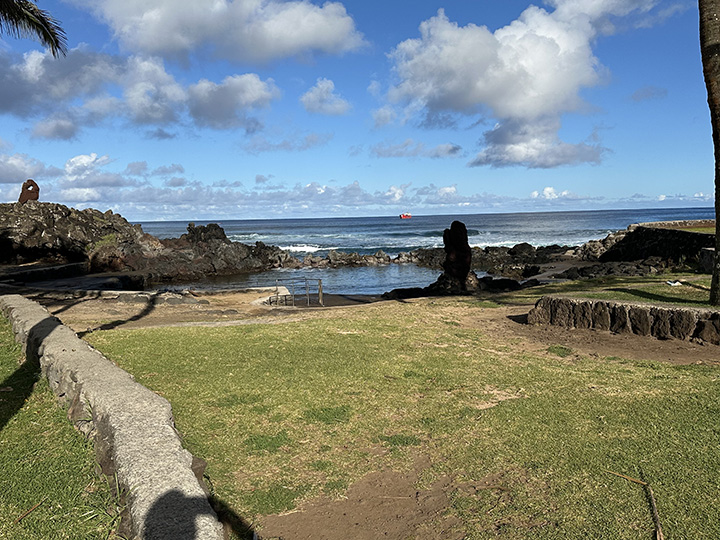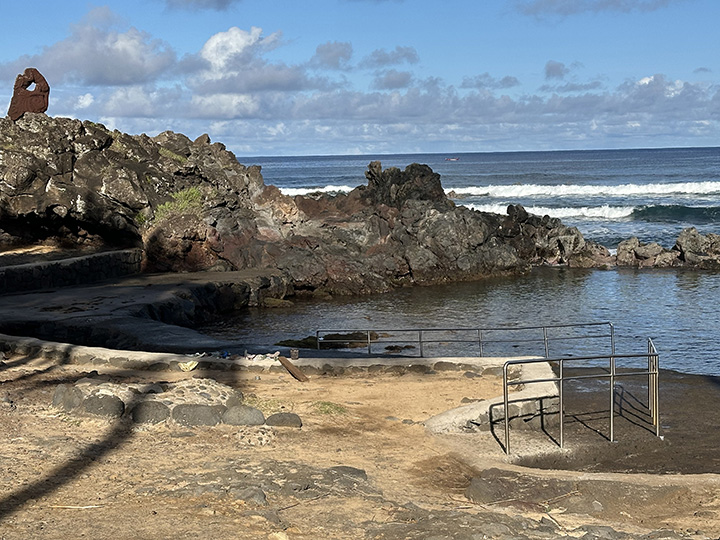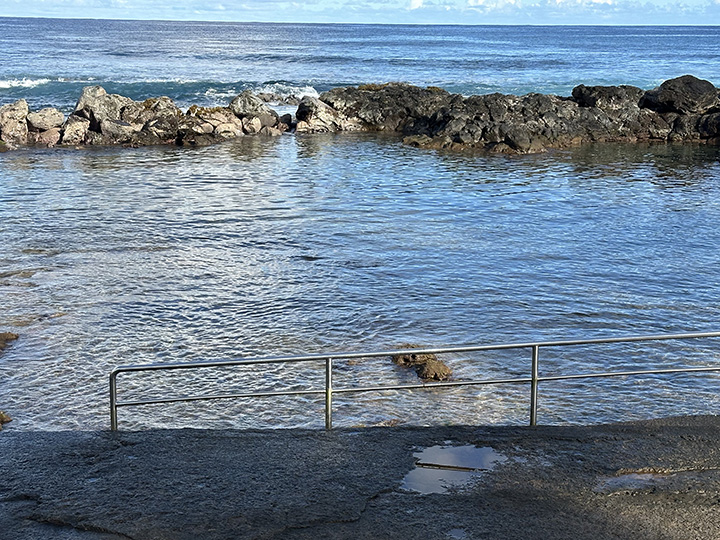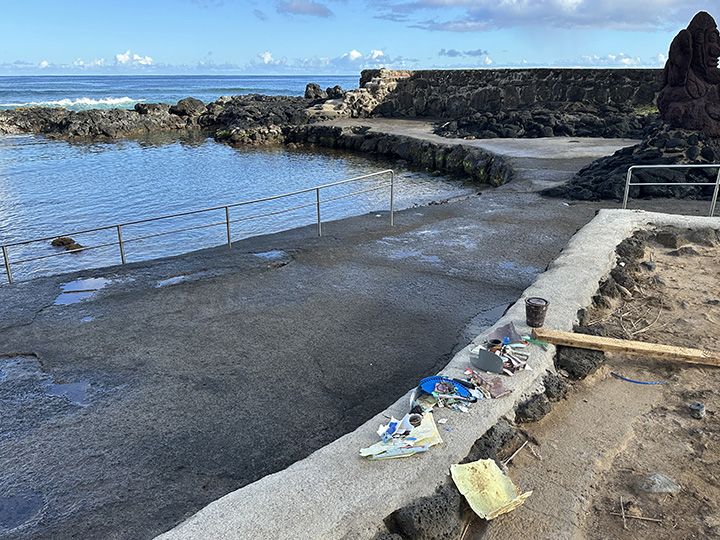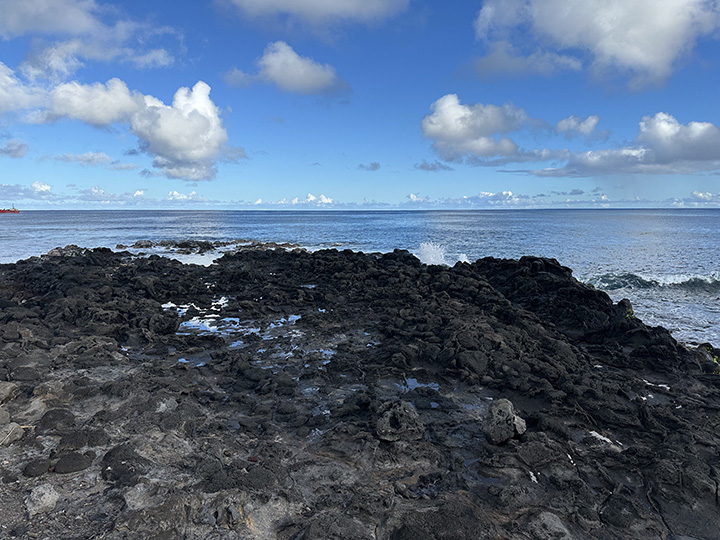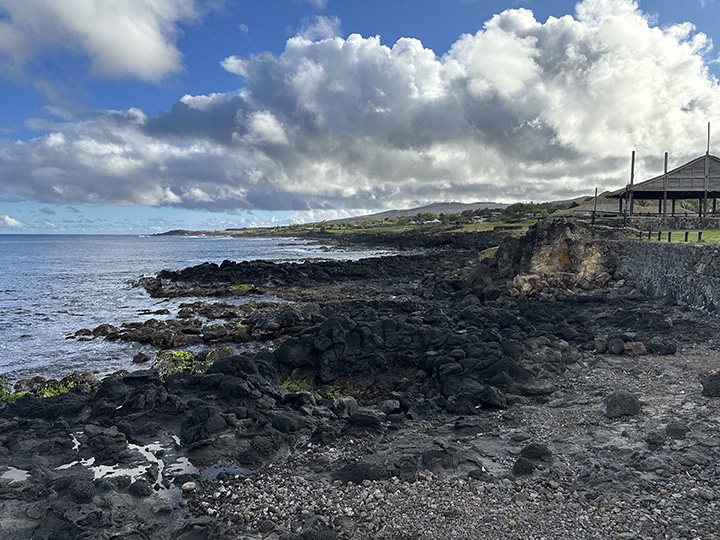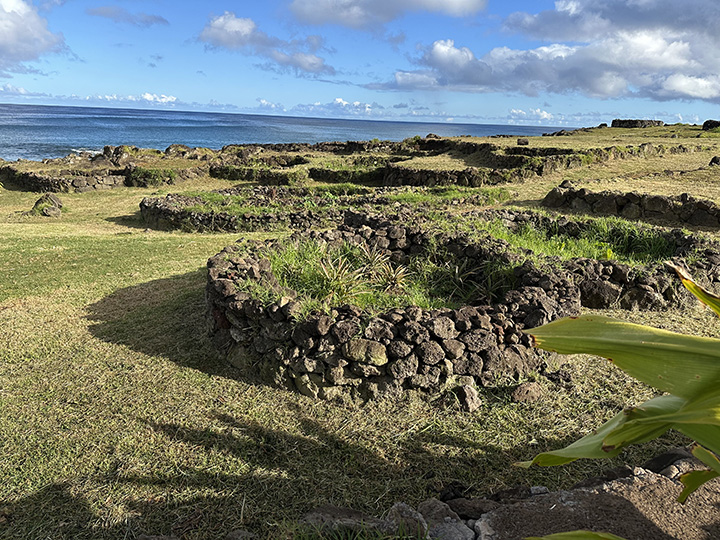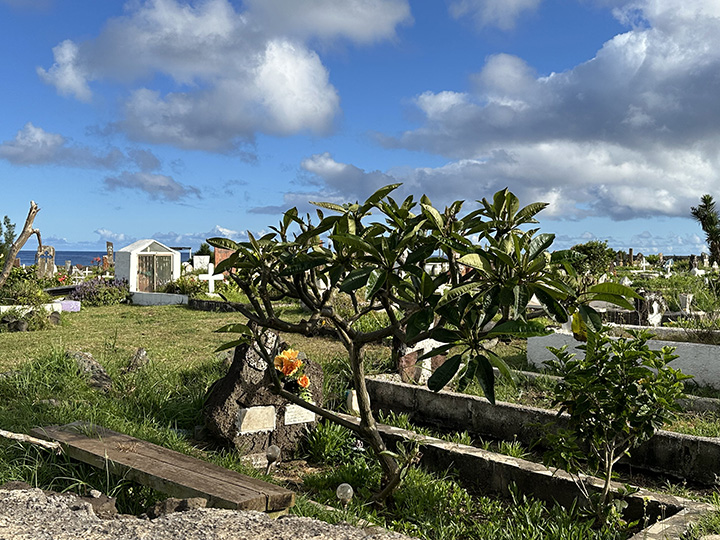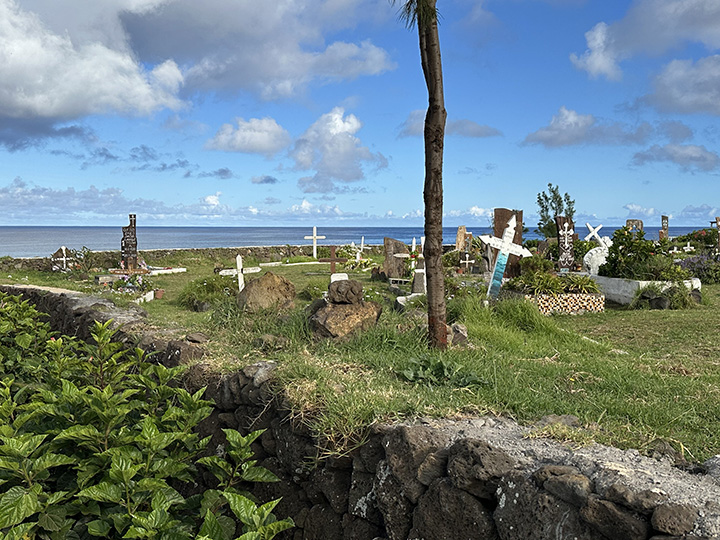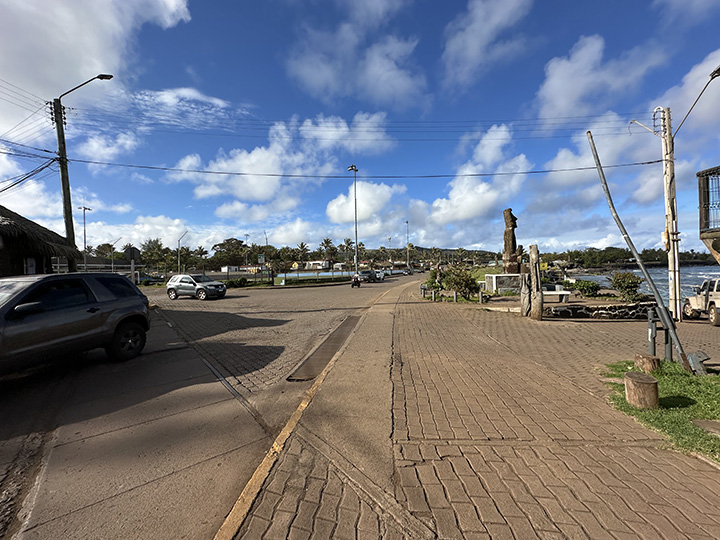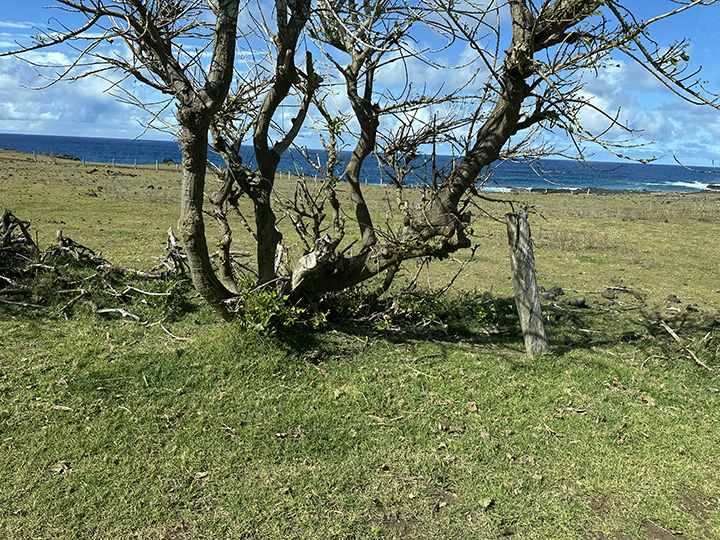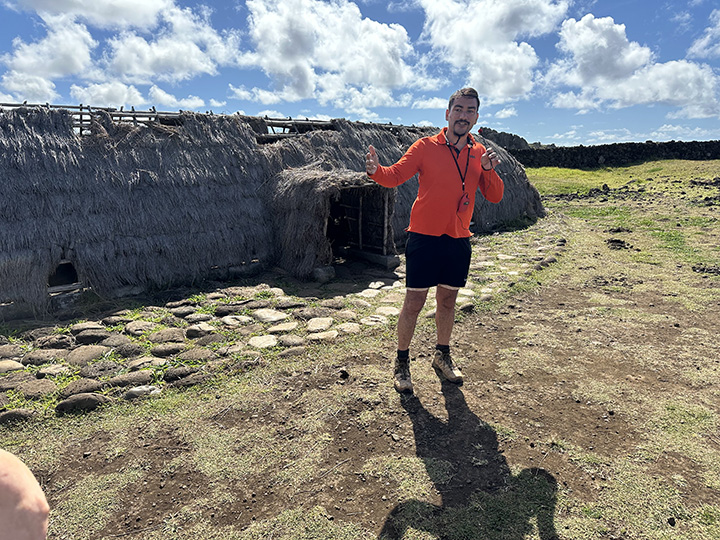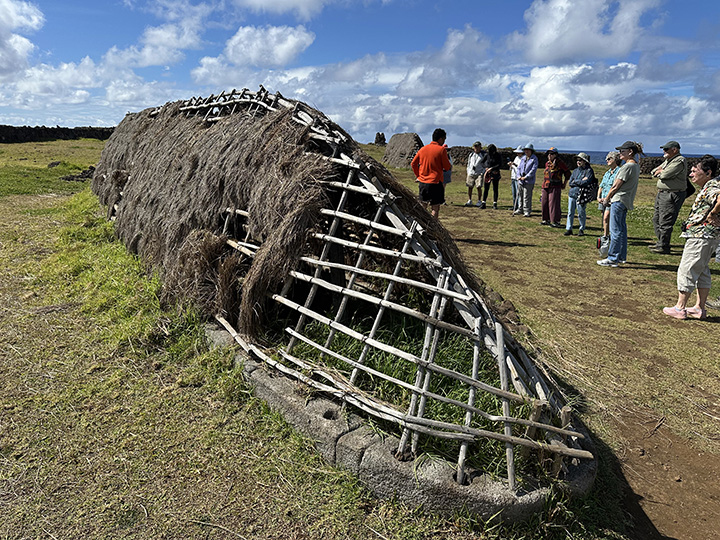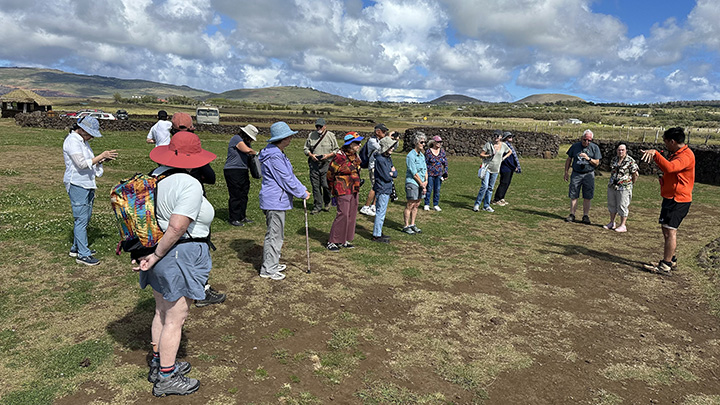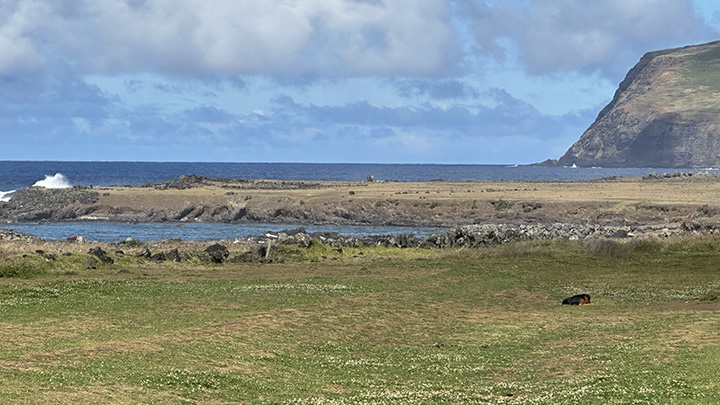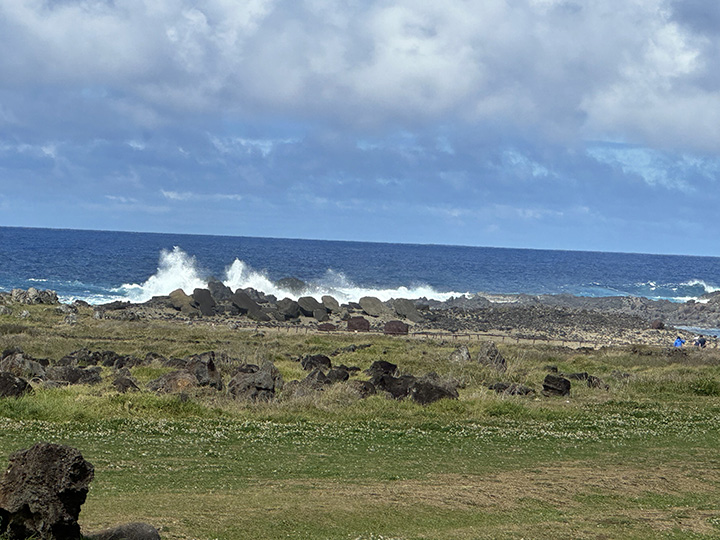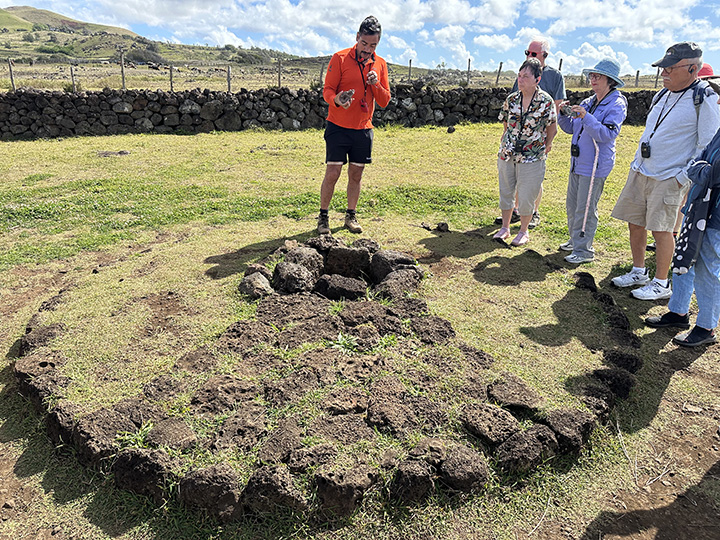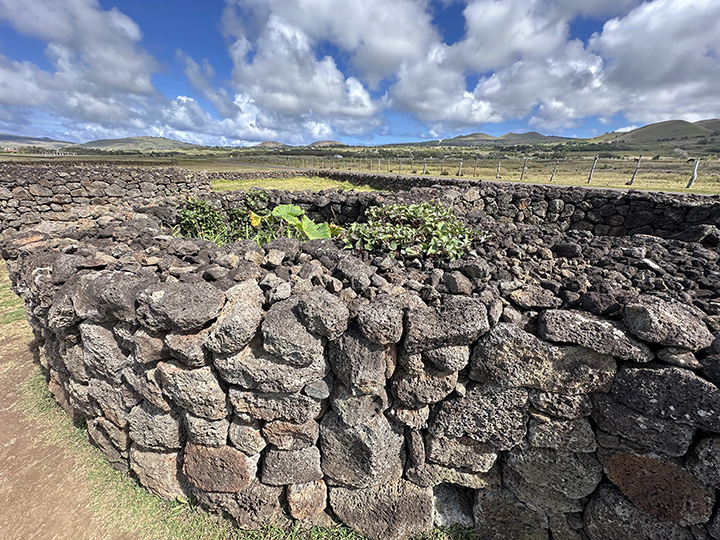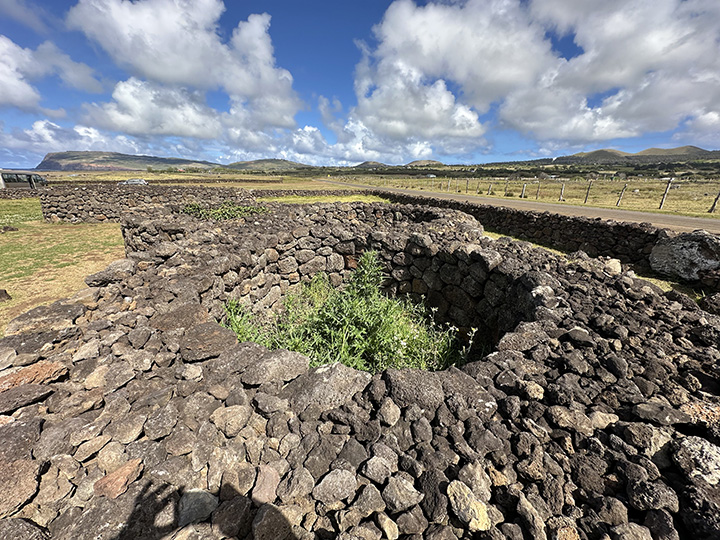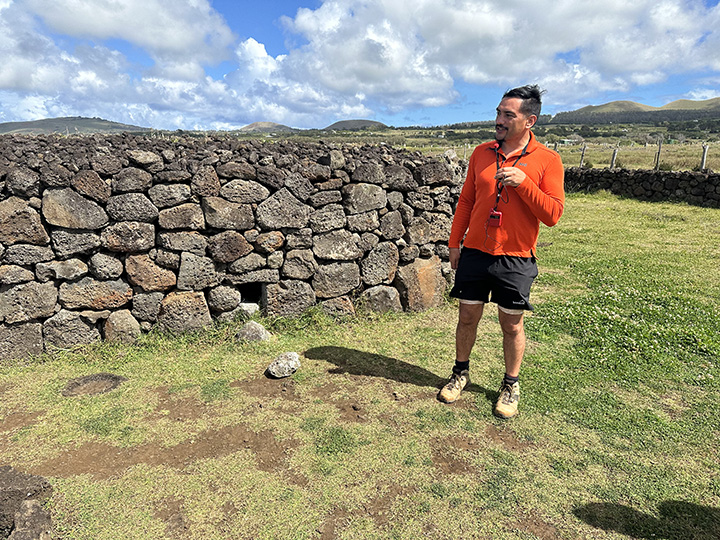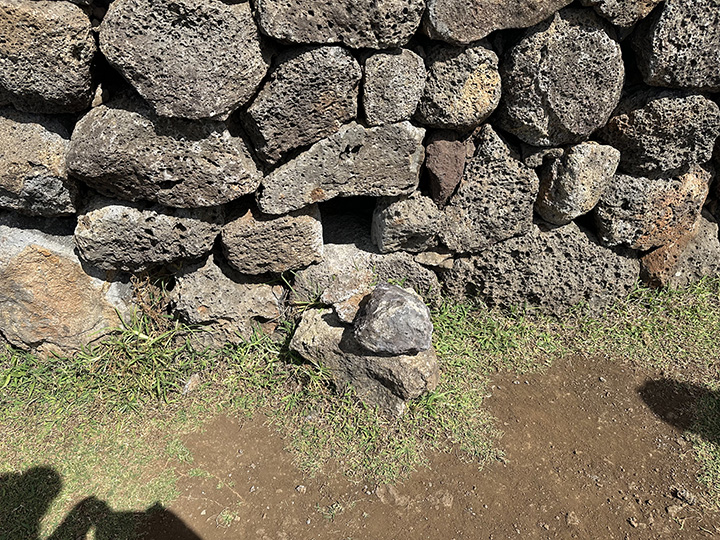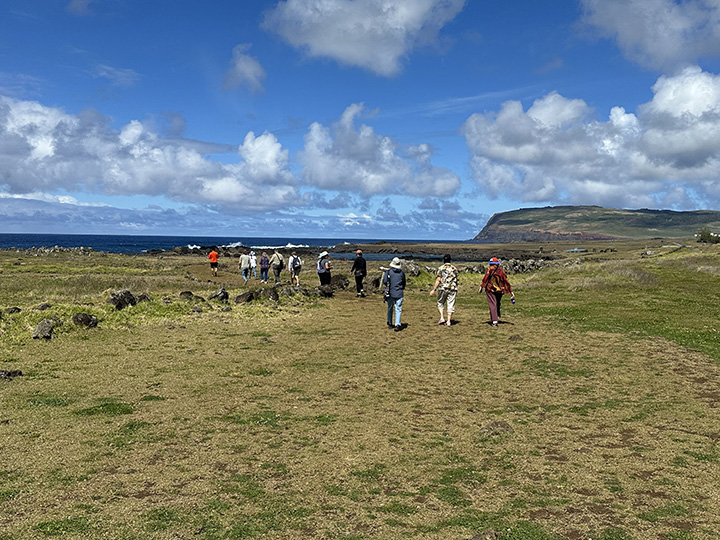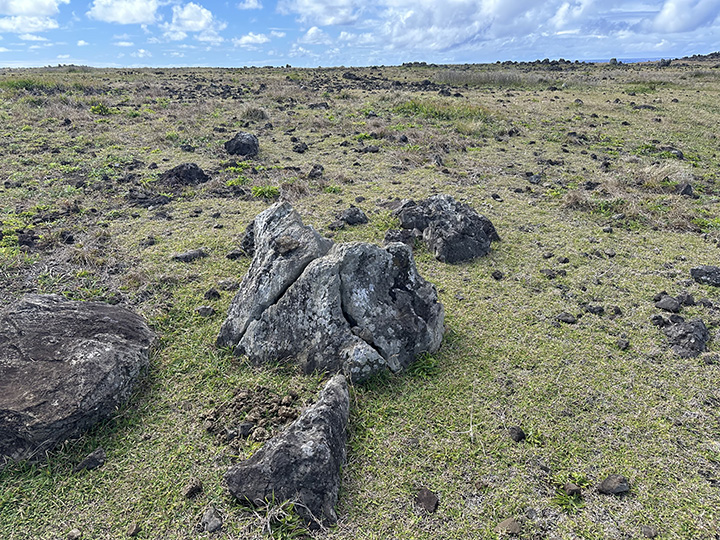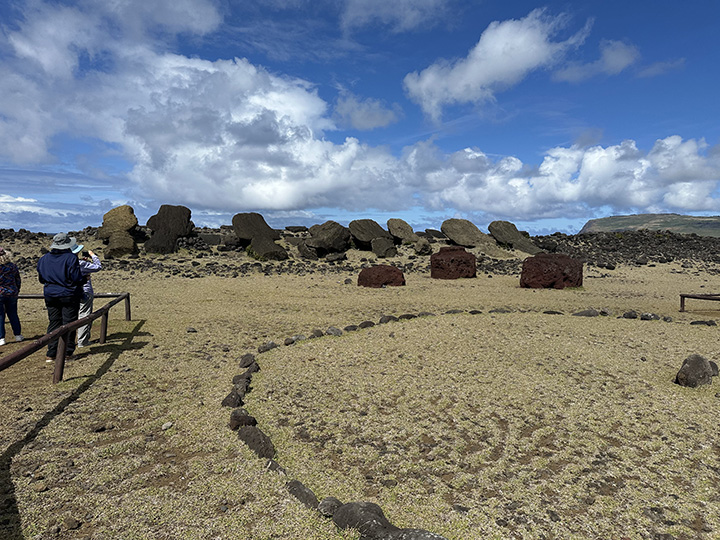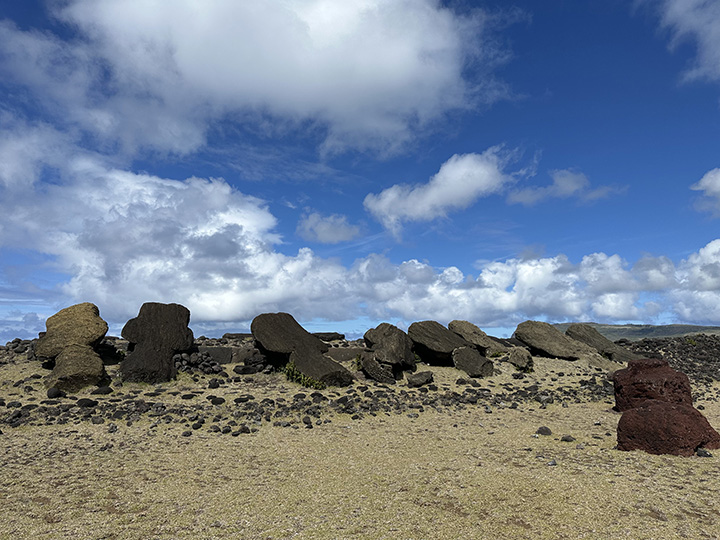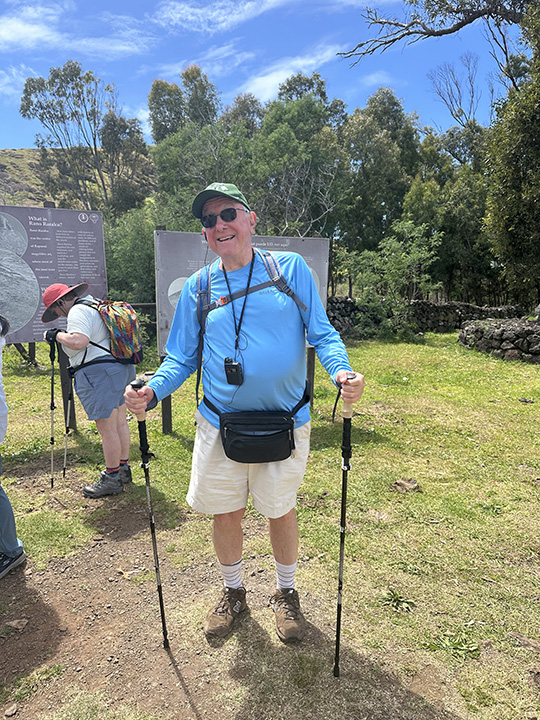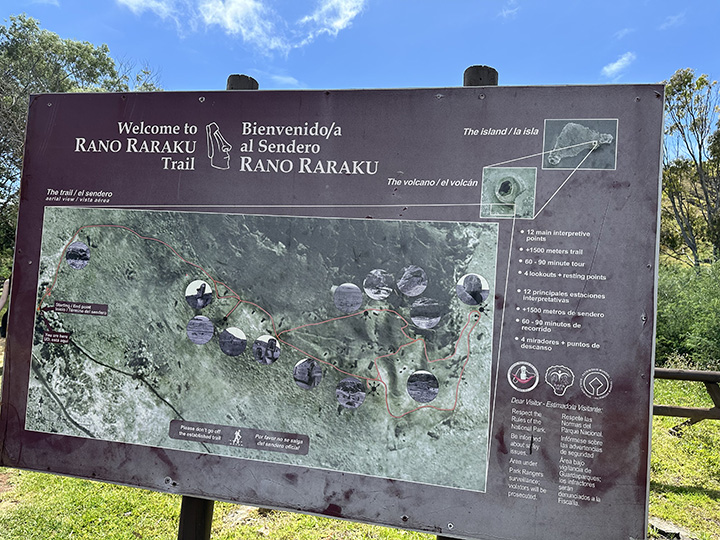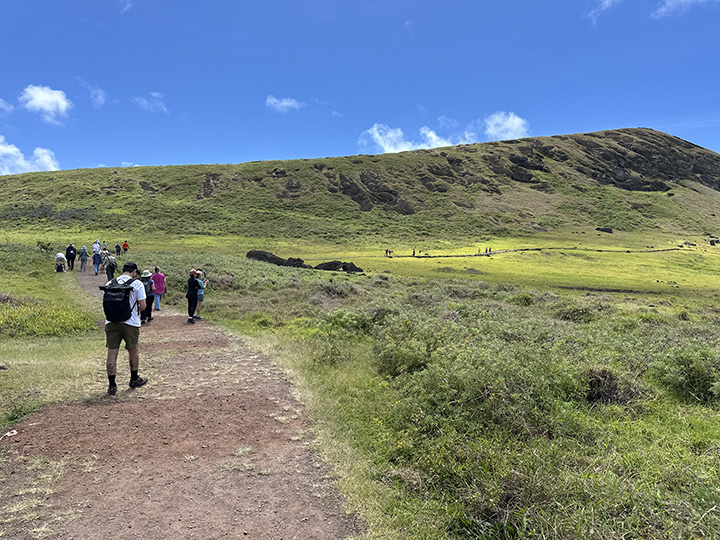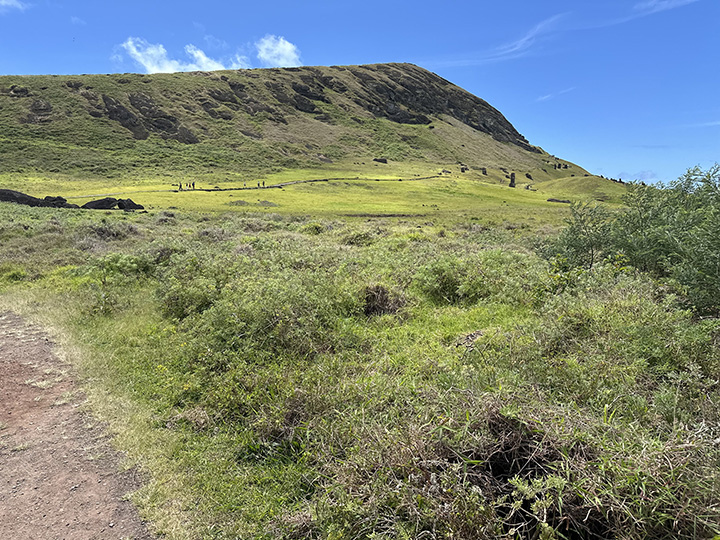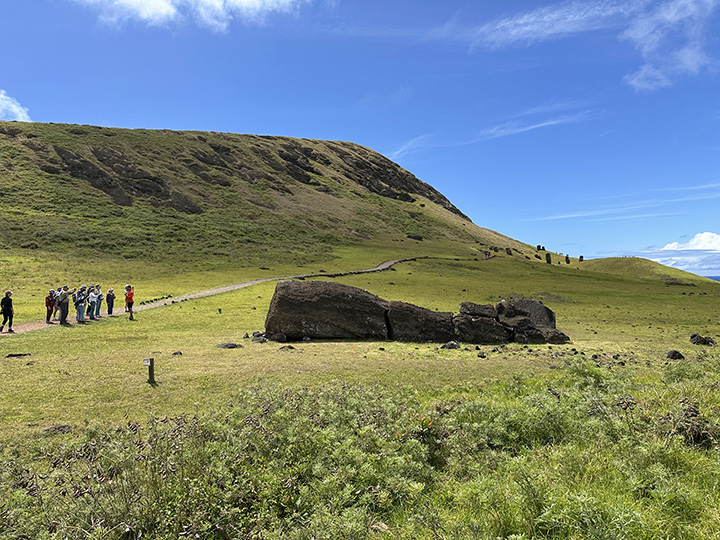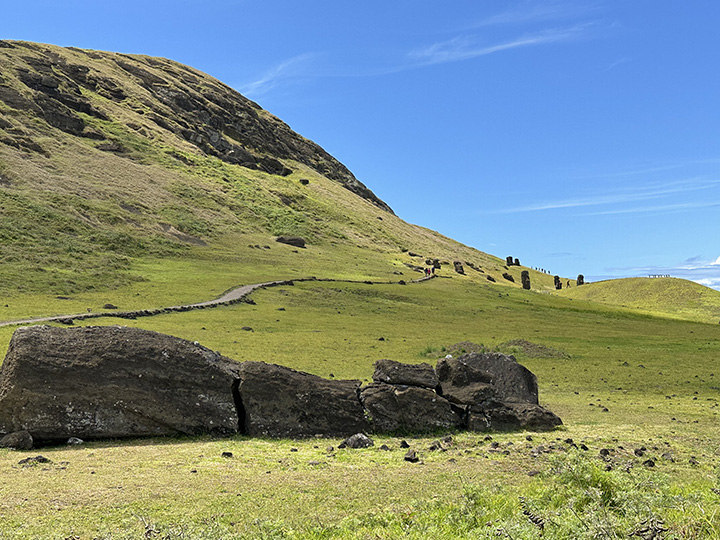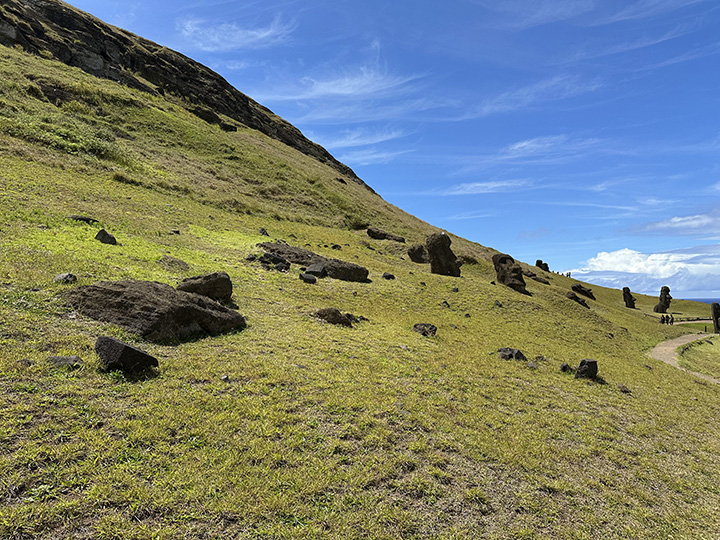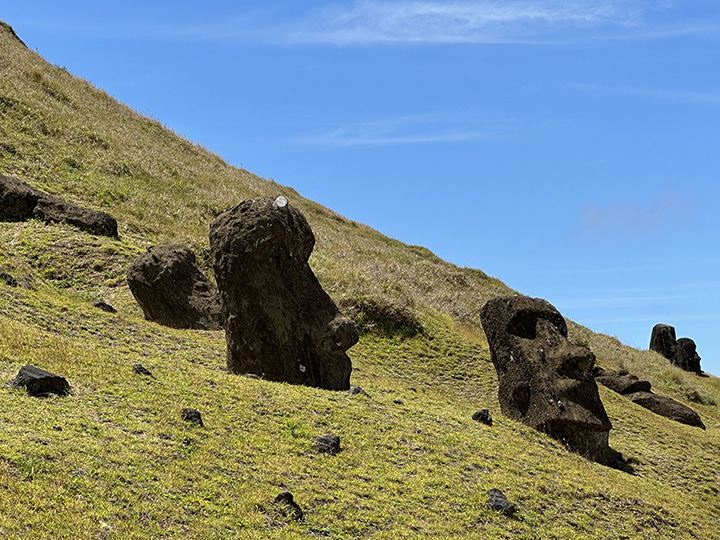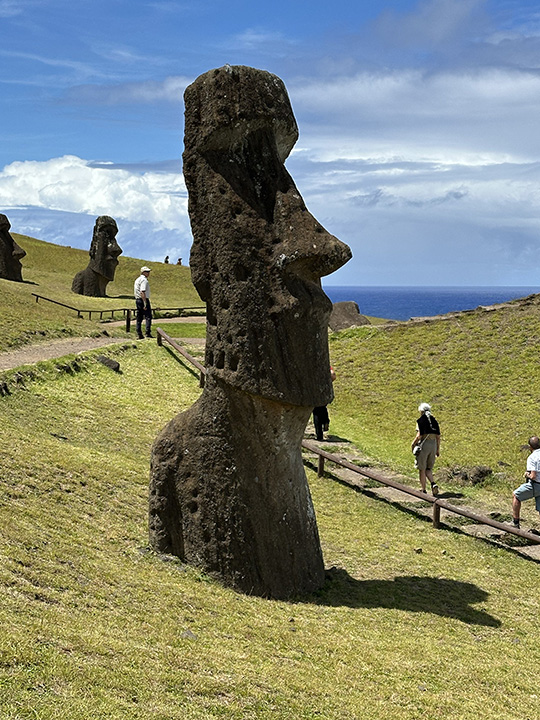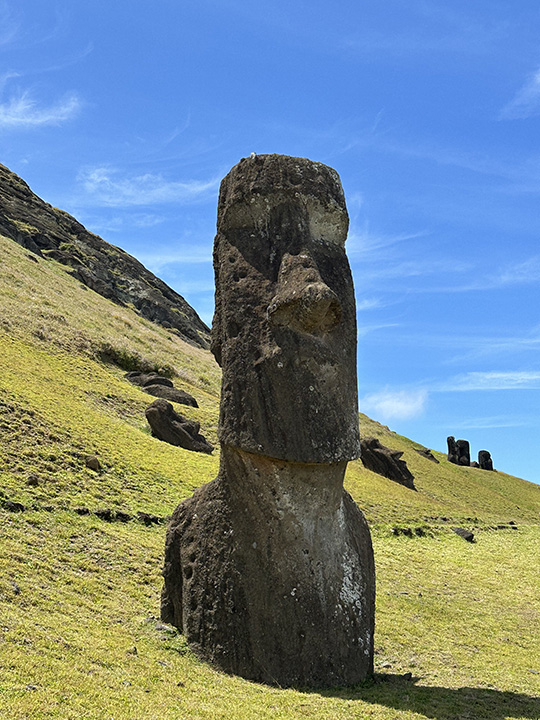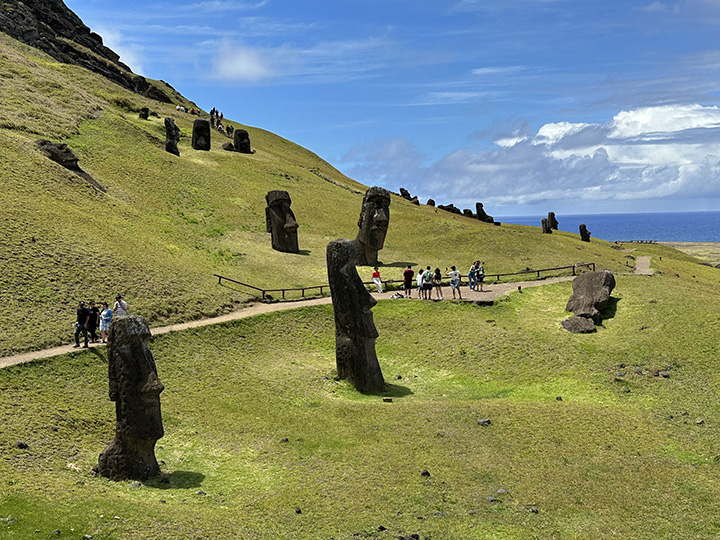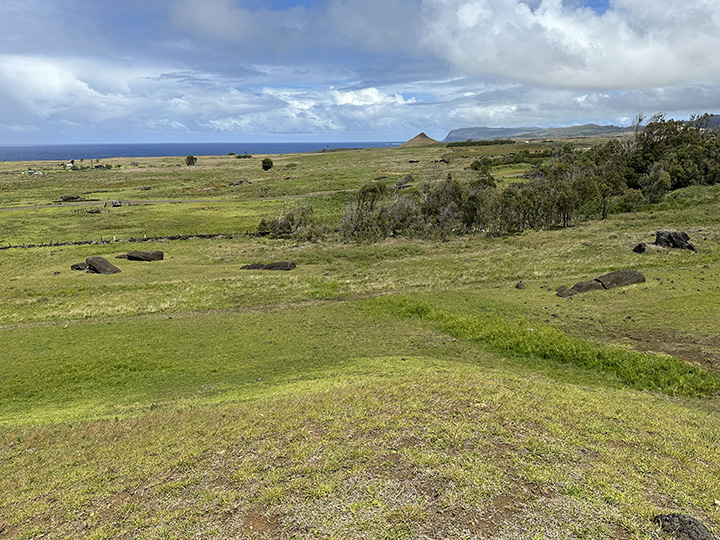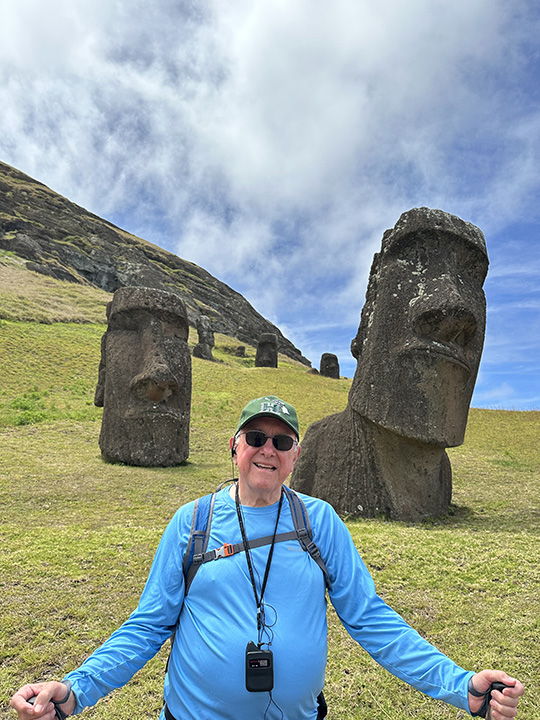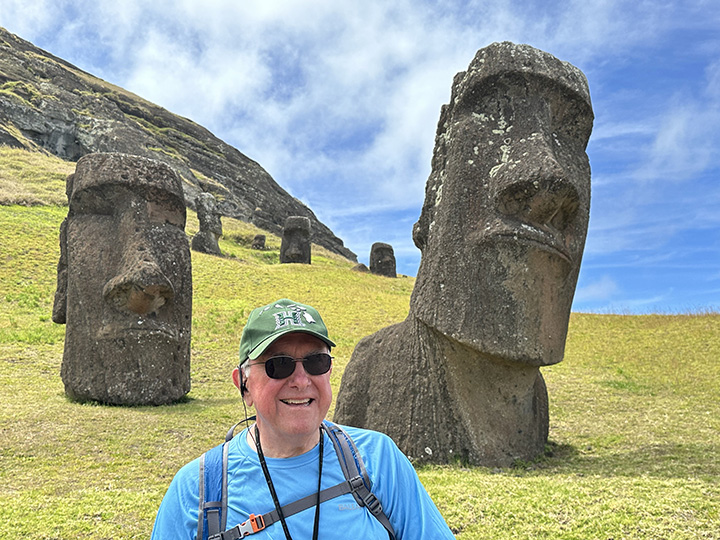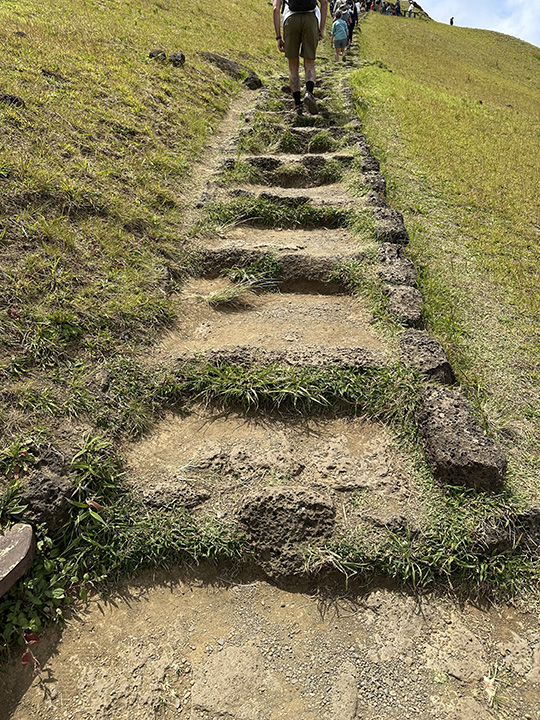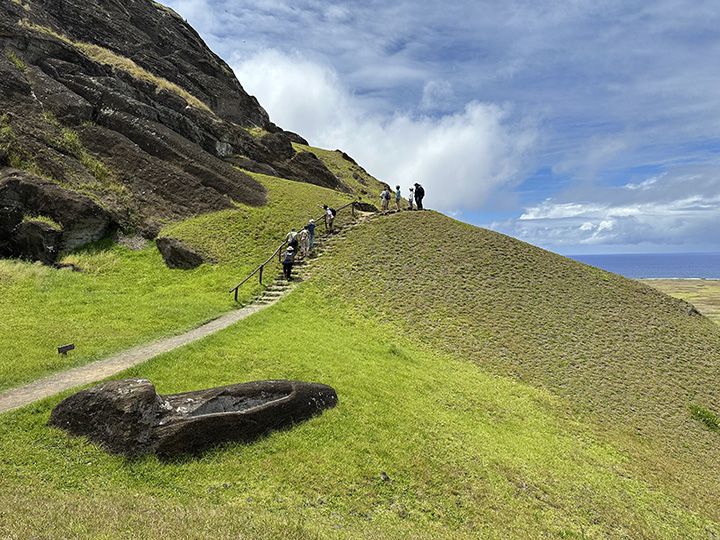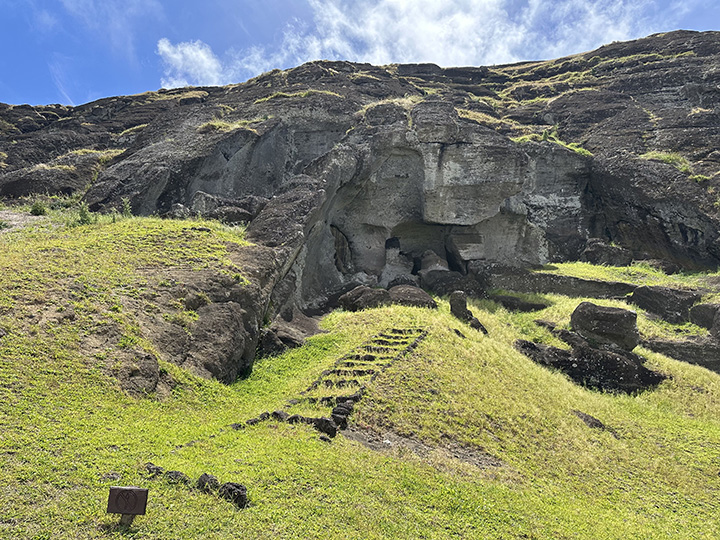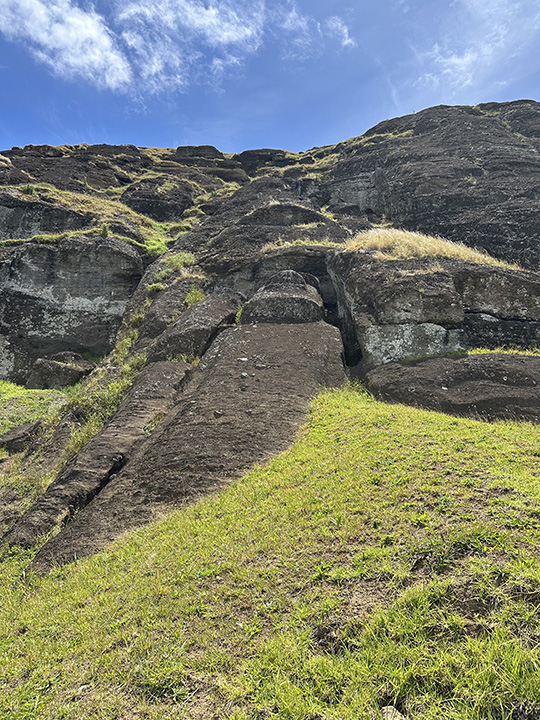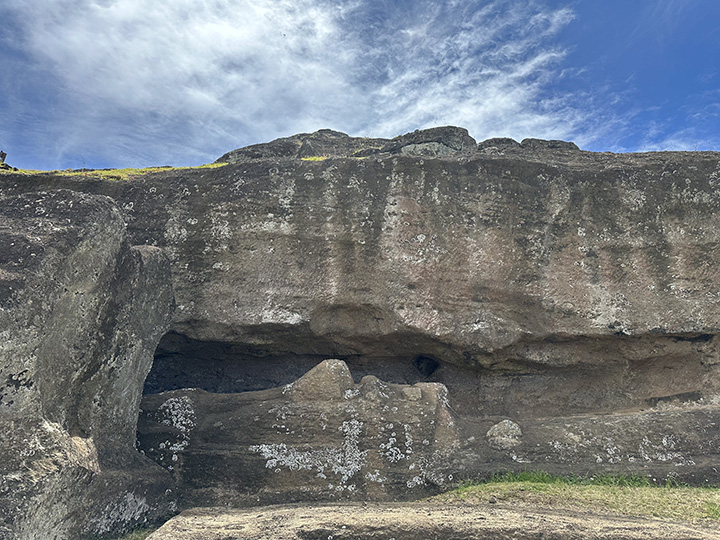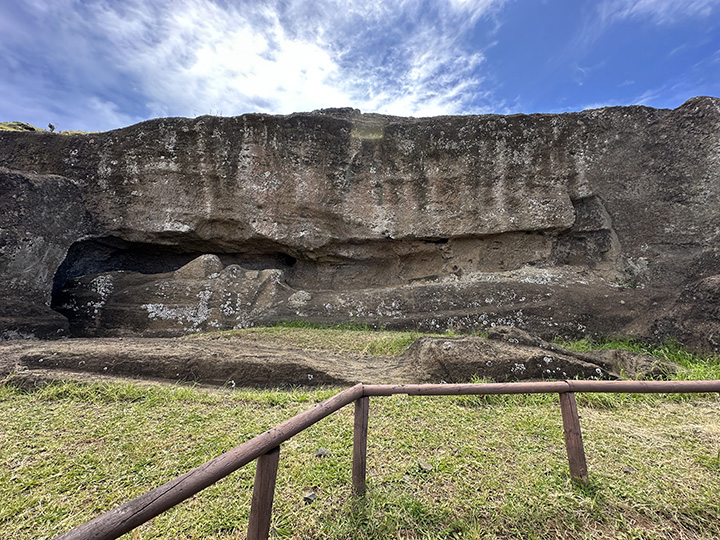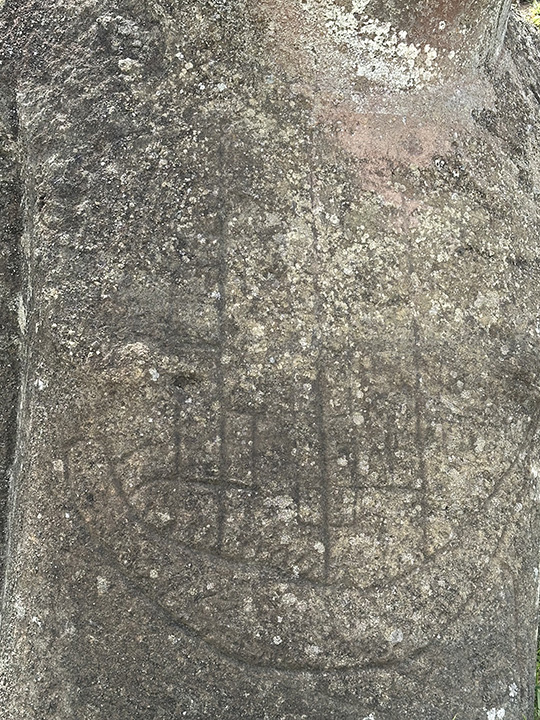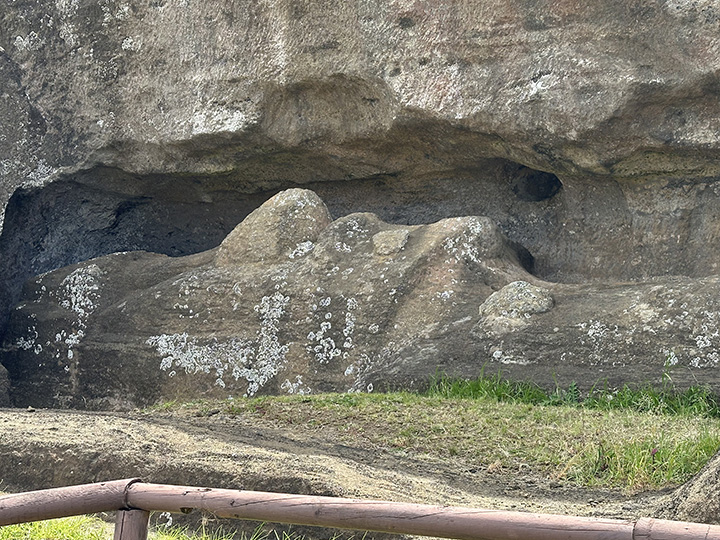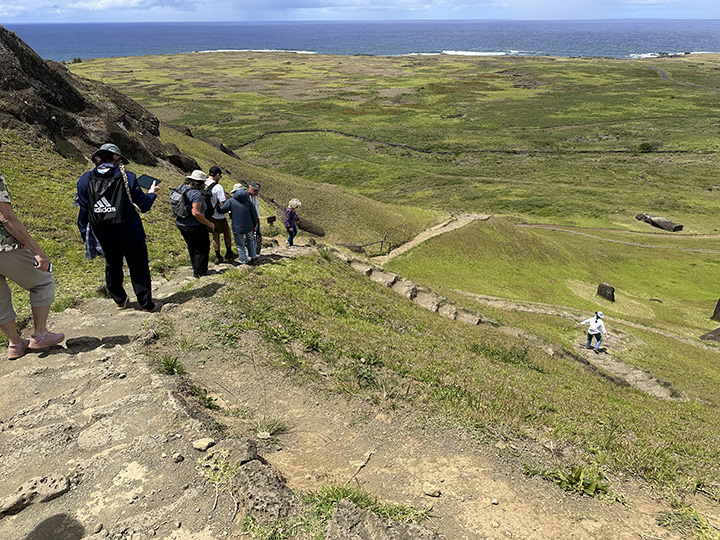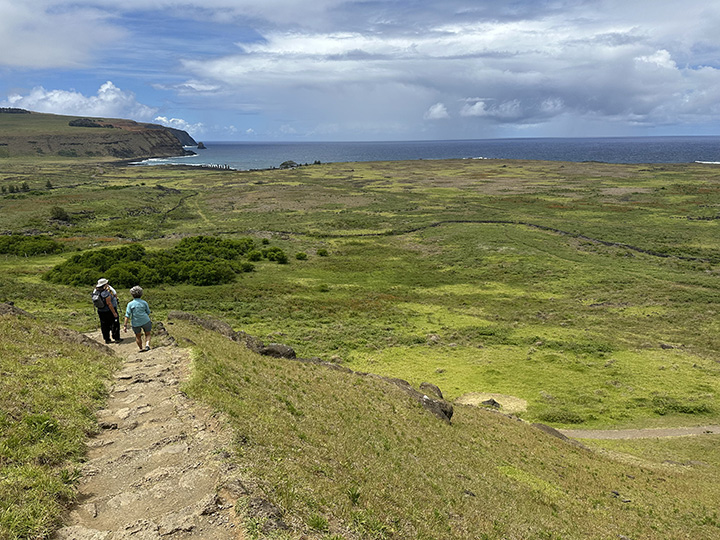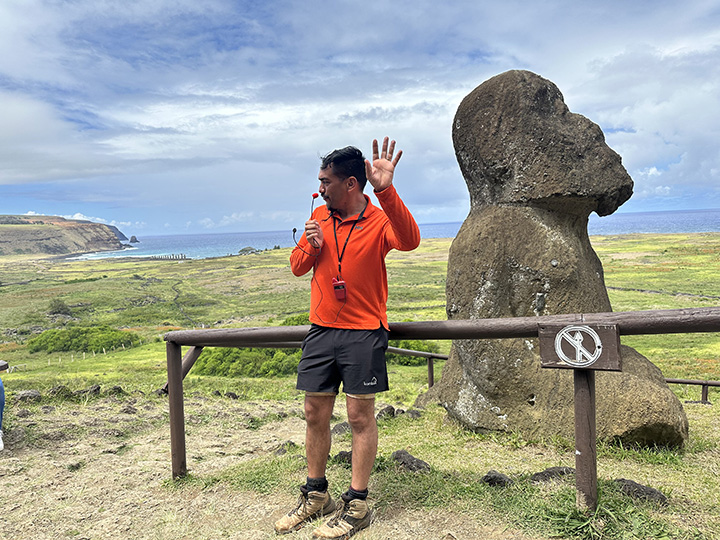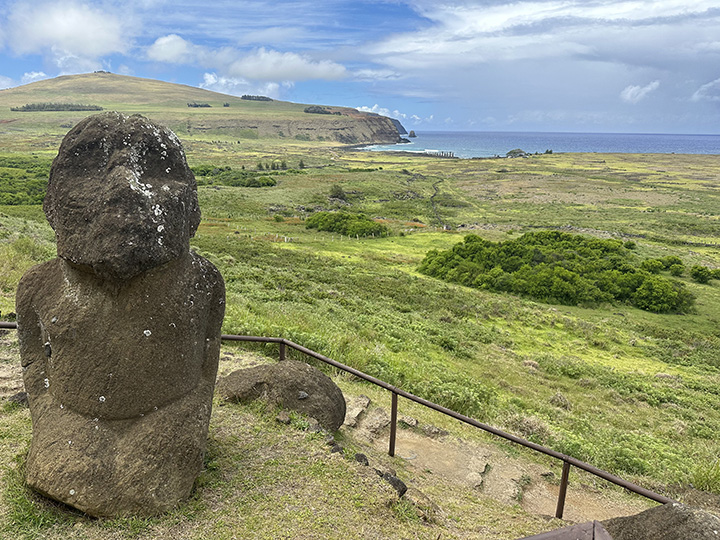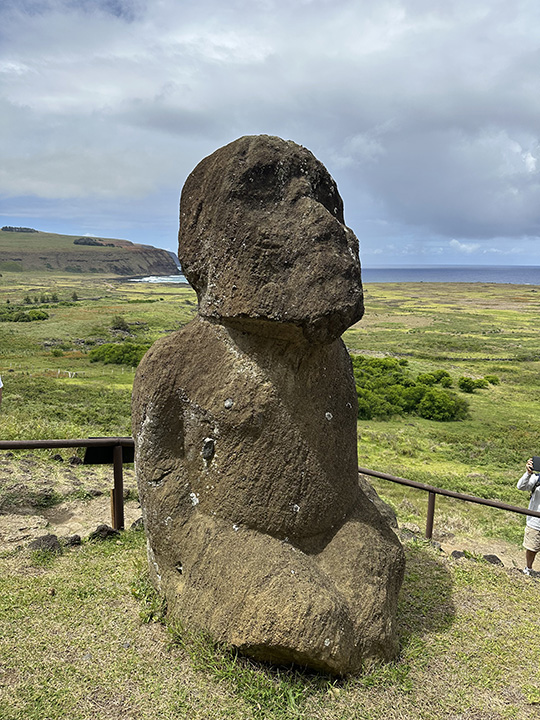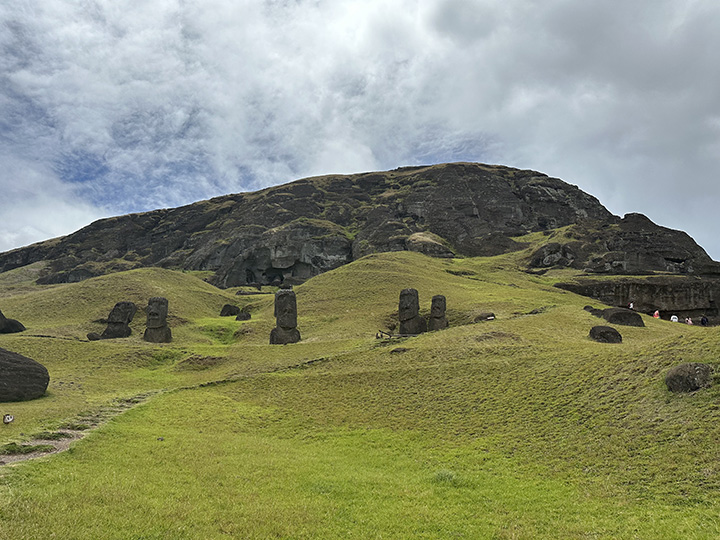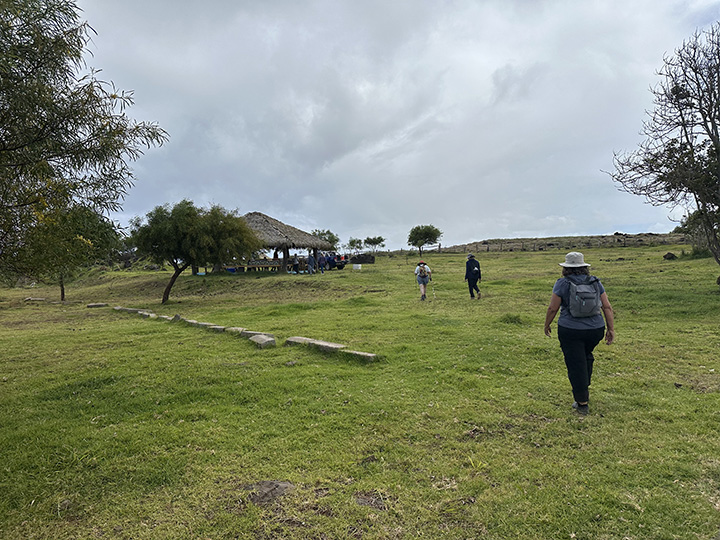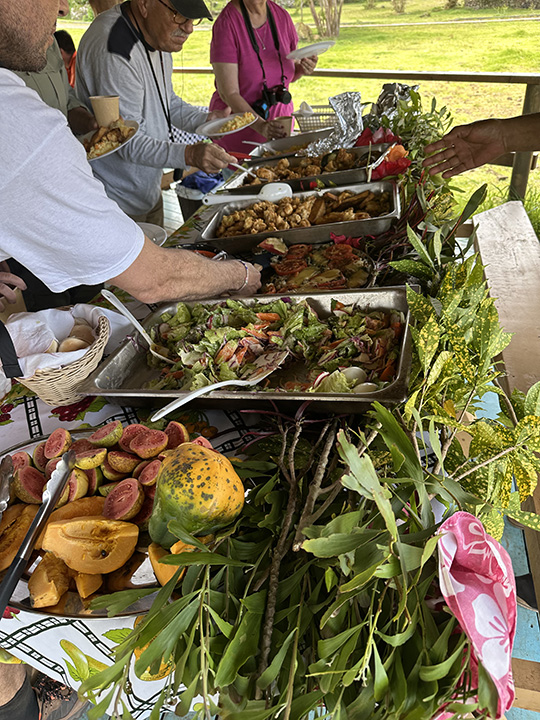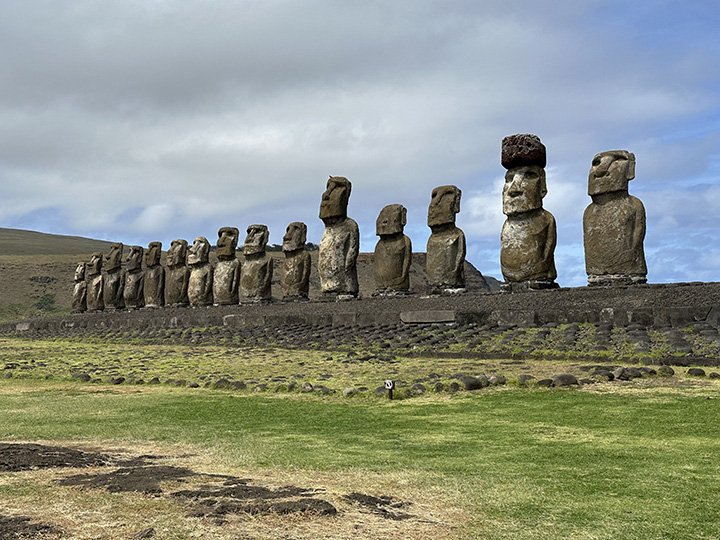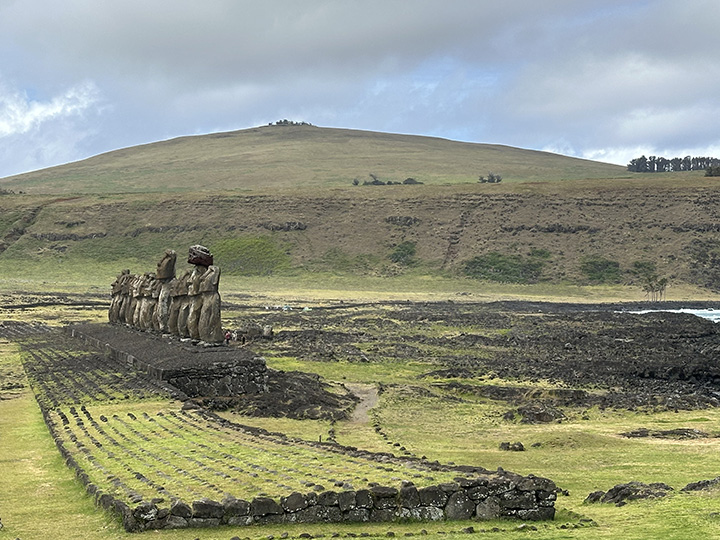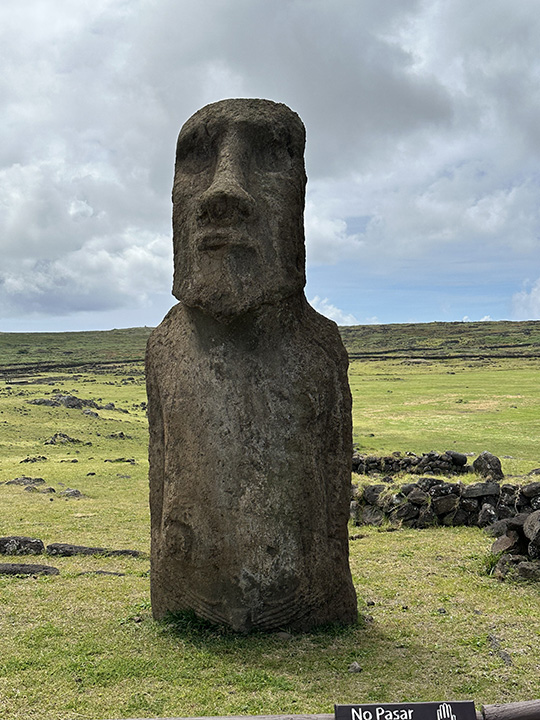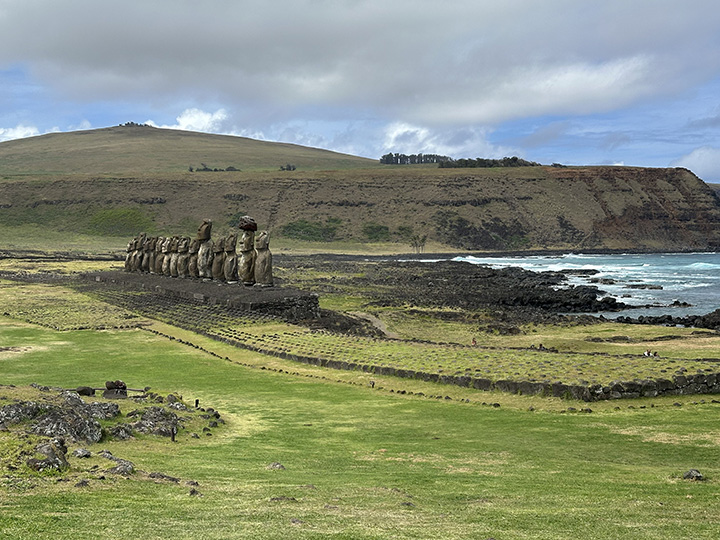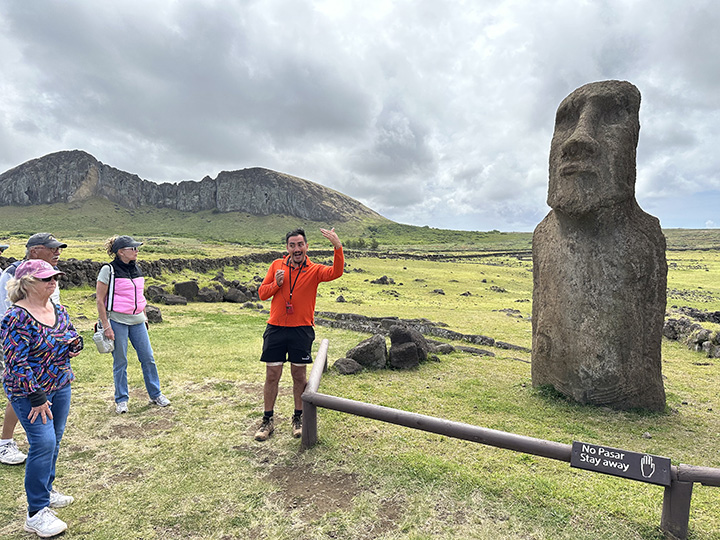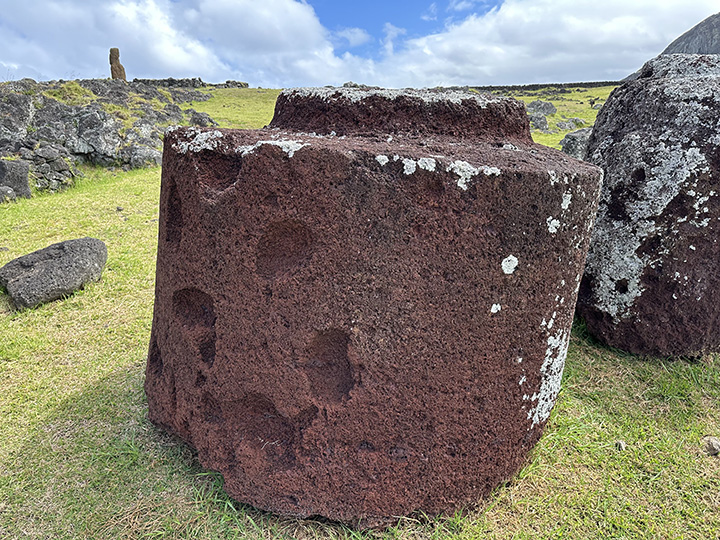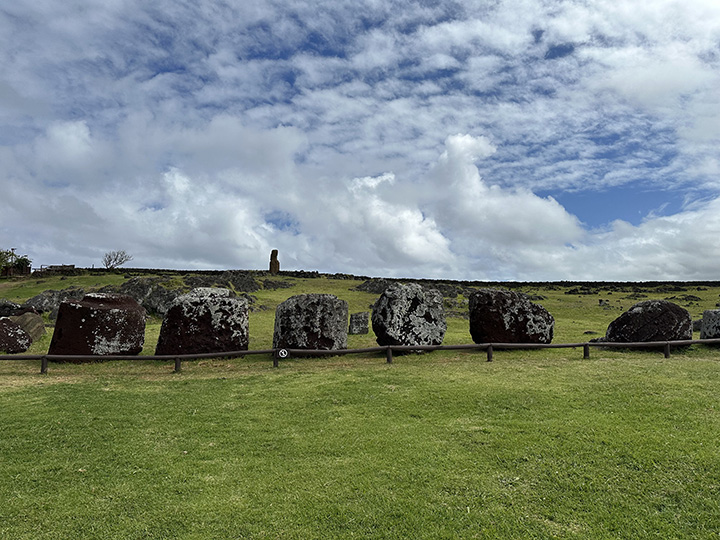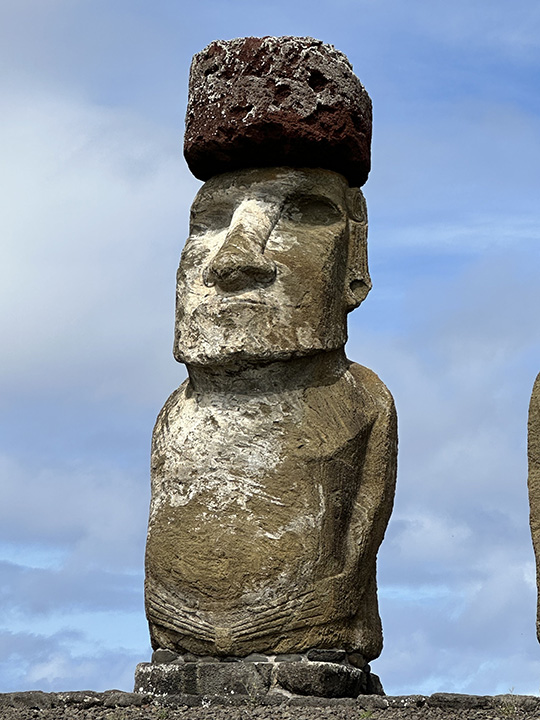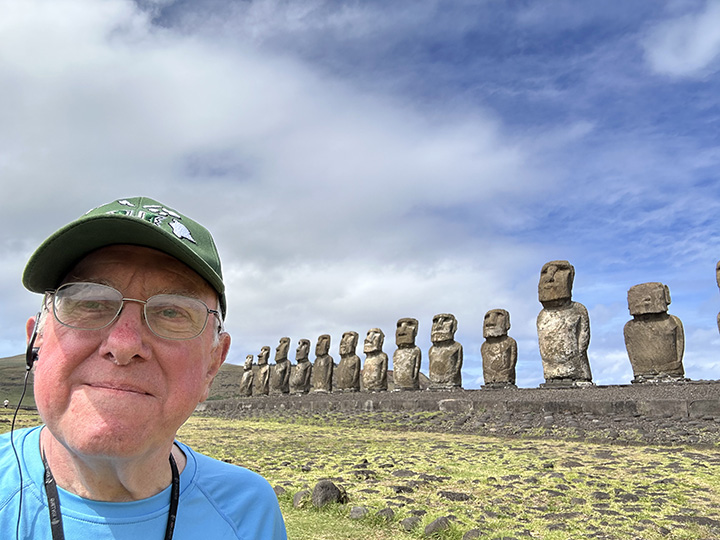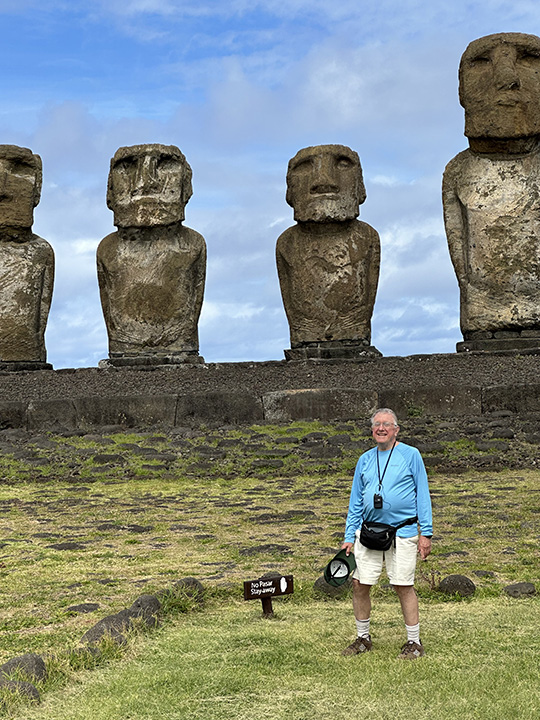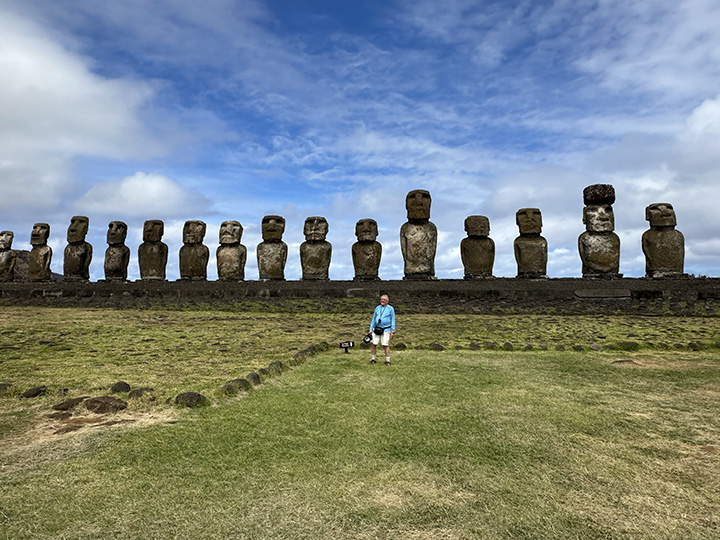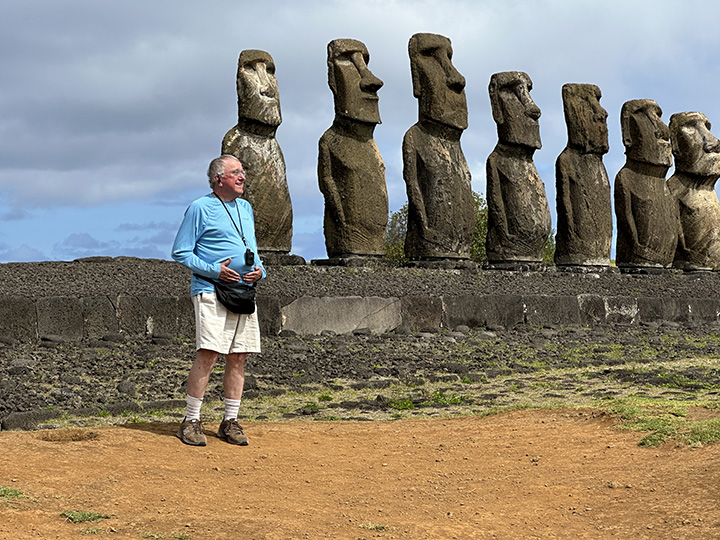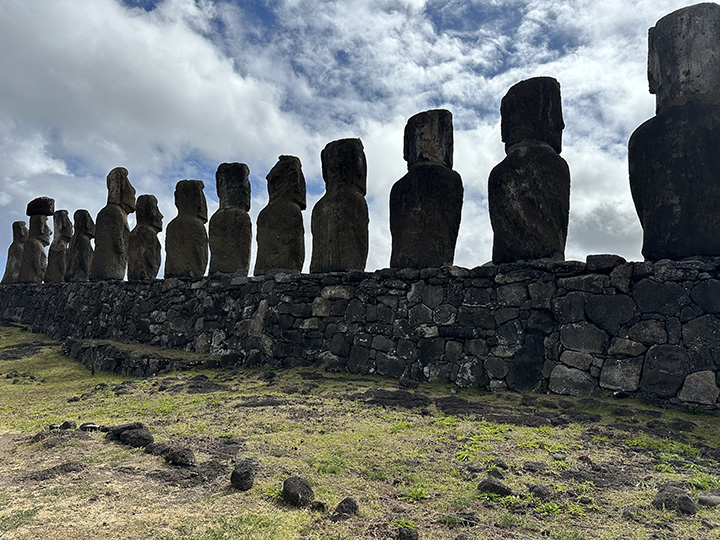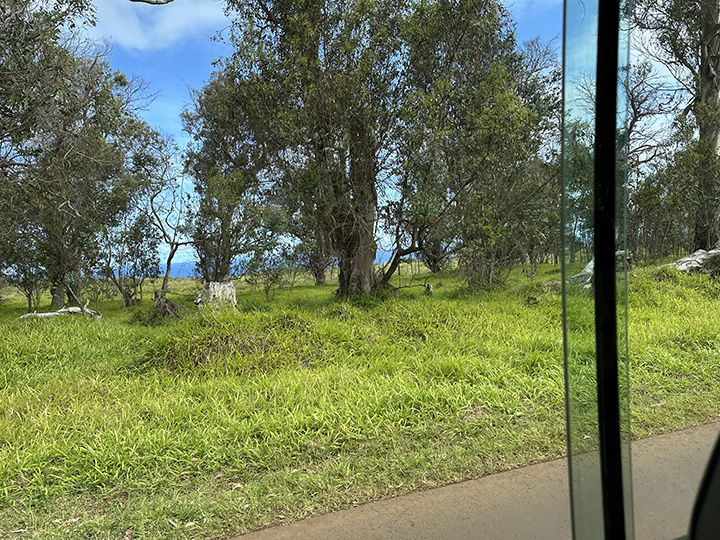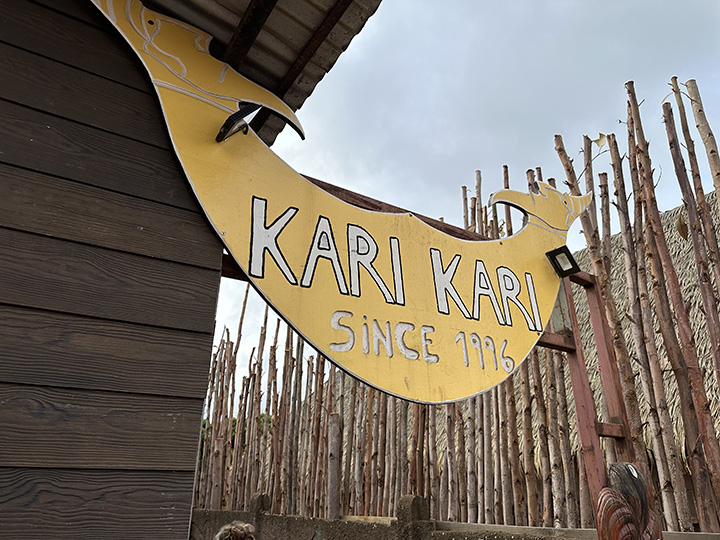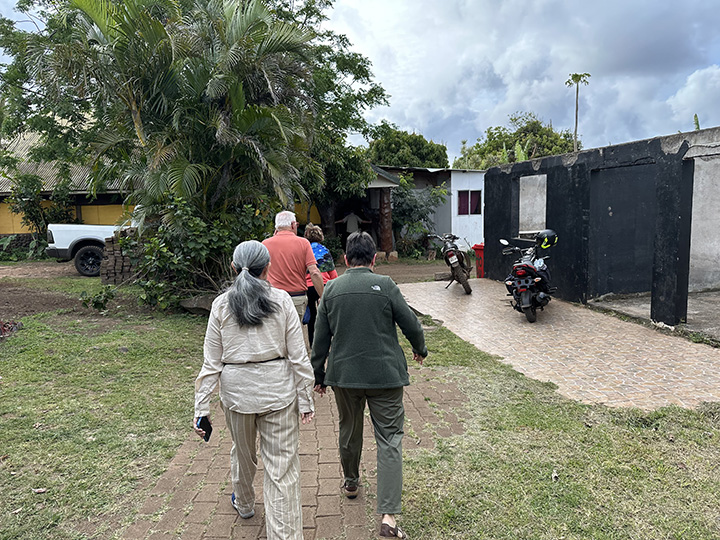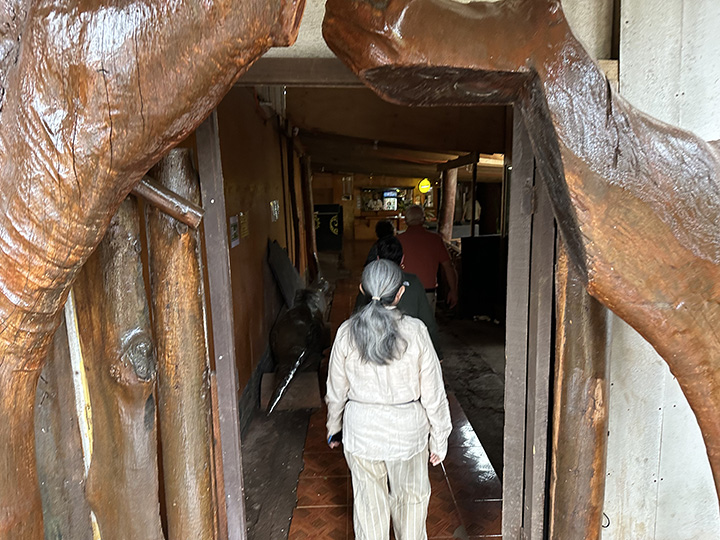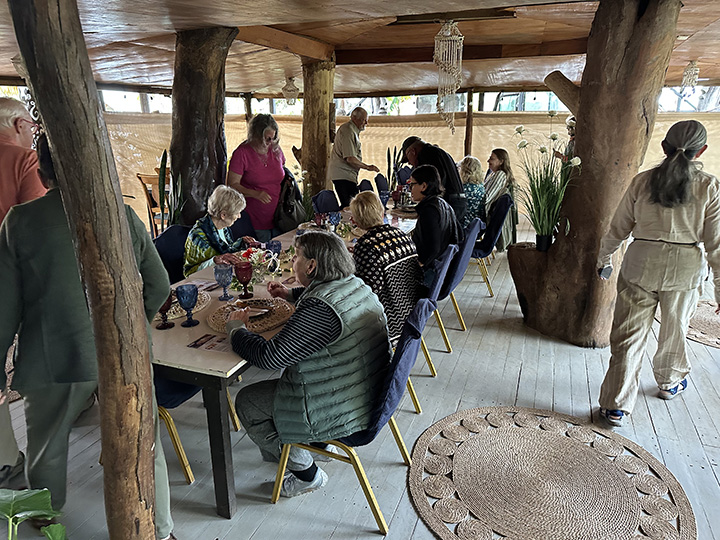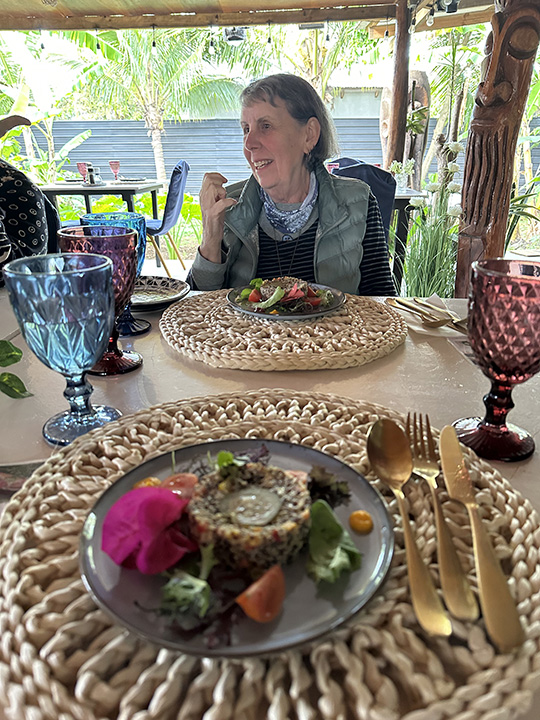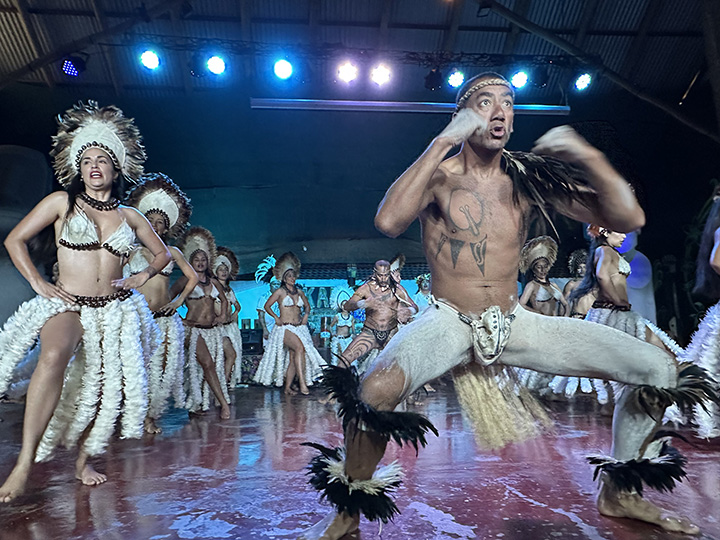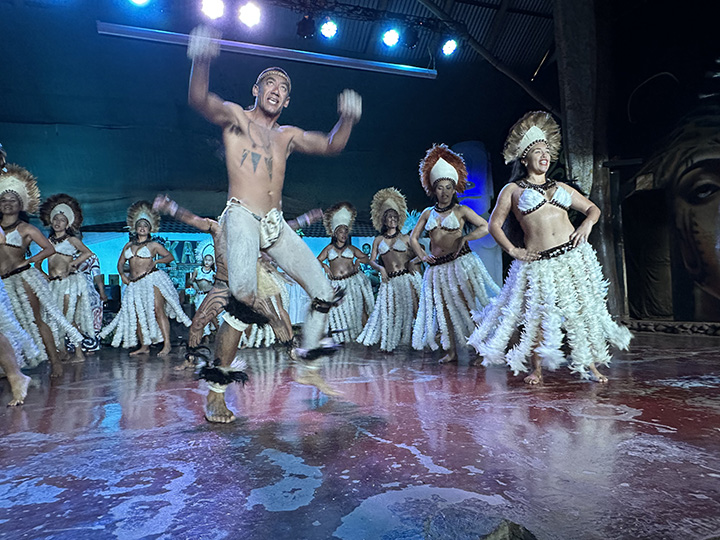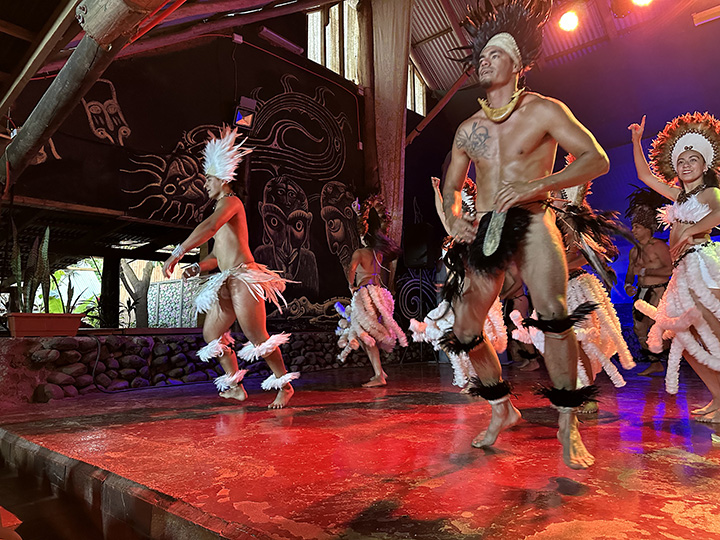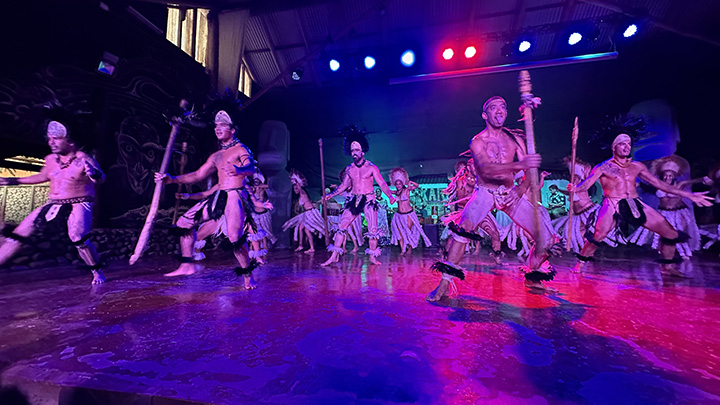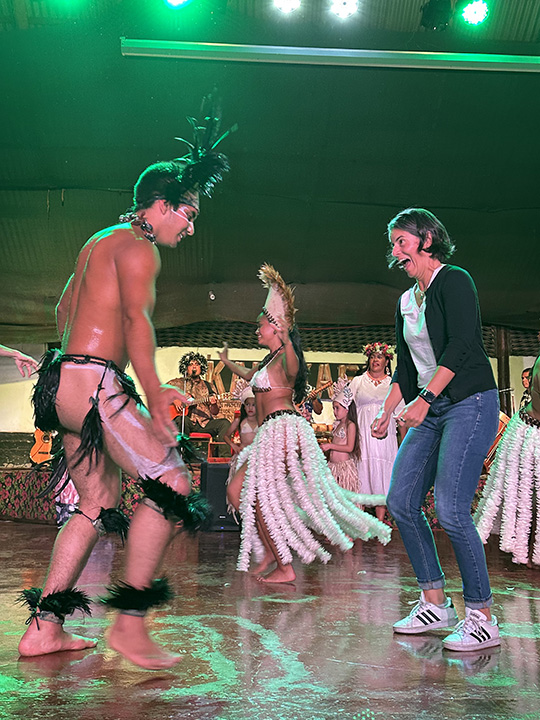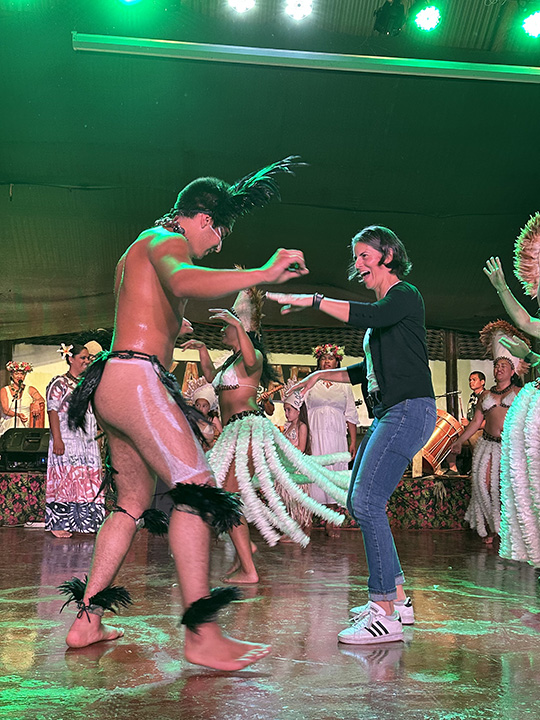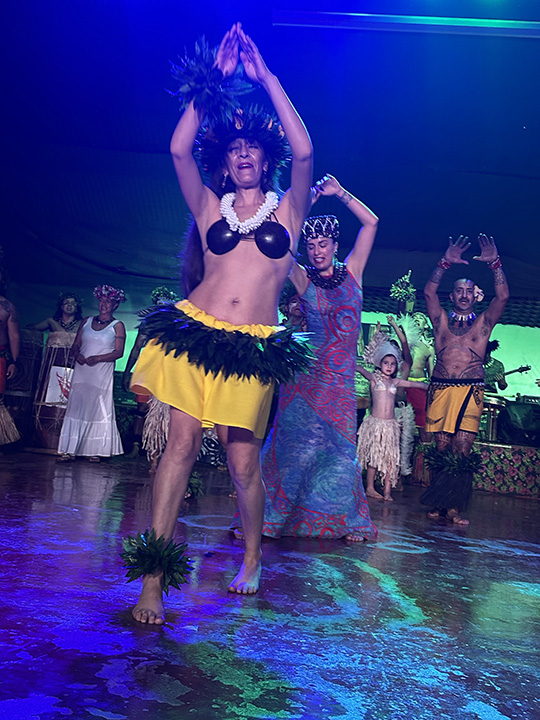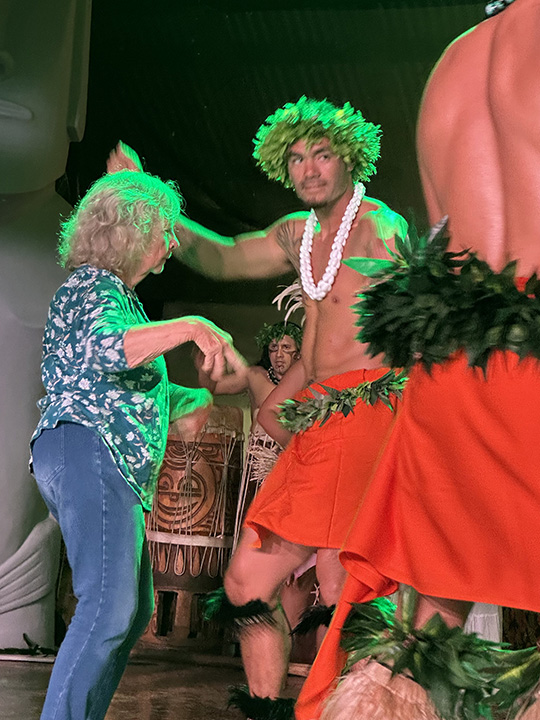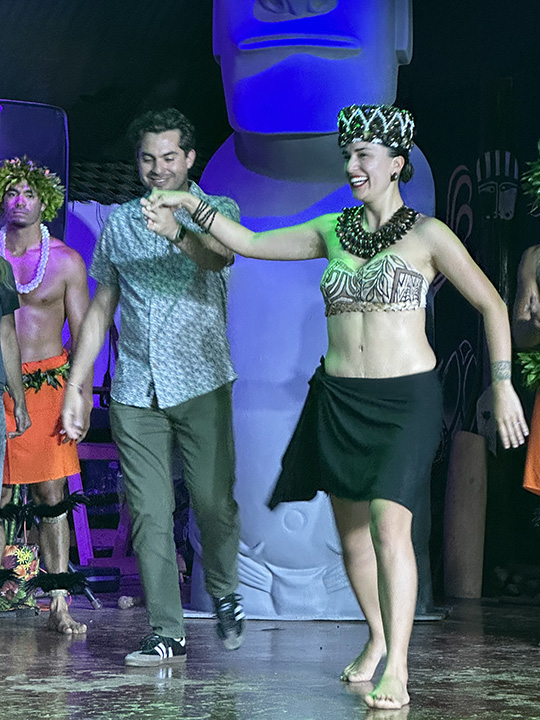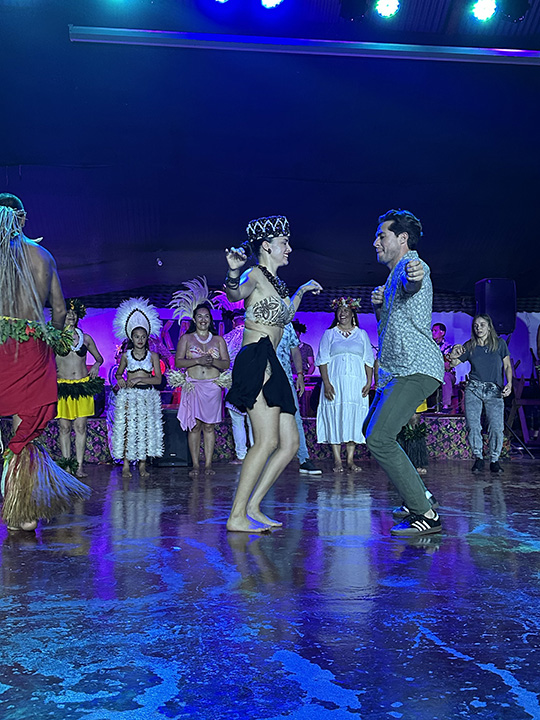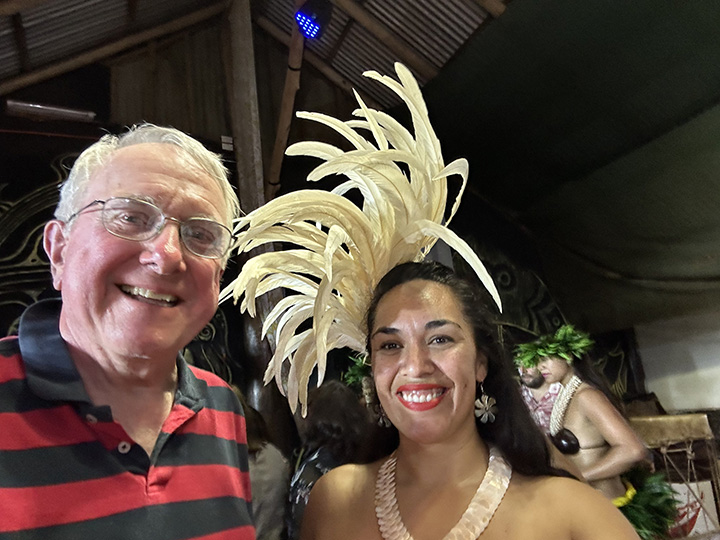|
We had a big day today. We visited a re-creation of a prehistoric village, hiked up to the moai quarry, ate really good food, and enjoyed a presentation of native dances.
To start the day I took a little walk by myself around the town. That's the fire station.
That’s the post office.
That's the Pacific Ocean.
That's the park again.
Those are stray dogs in the park.
And that's the park without stray dogs.
I guess I could go for a morning swim in the municipal swimming hole.
It’s an area protected from the pounding surf, full of nice clean water and sometimes turtles. It’s a good place for families to bring the kids to swim.
I was told sea turtles like to swim around in the pool but I didn't see any.
I did see a bunch of trash that had been pulled from the pool. This illustrates a monumental problem currently facing Easter Island as described by the Seaside Sustainability organization. "Unlimited dumping of trash into the Pacific Ocean has resulted in mounds of plastic waste washing onto the shore and blending into ocean ecosystems. A nearby “trash vortex”--a swirling mass of garbage floating in the South Pacific--incessantly feeds waste to Rapa Nui. It is only recently that this vortex has inundated Easter Island with trash, but the change within the last 25 years has been “disastrous,” according to inhabitants. Macro- and microparticles of plastic overrun the shores, invade the beaches, and swim with the fishes, as it were. Worst of all, because Easter Island’s population is minute, much of the plastic is generated externally, particularly by fishing boats, and the small community is unable to keep up with incoming trash for which they are not responsible. Easter Island is just one coastal community relegated to the role of collateral victims in global industry’s wastefulness, and the problem shows no sign of abating."
There aren't many sandy beaches on Easter Island.
This is about as good as it gets, most places around here.
Stone gardens are abundant.
As are graves.
OK, look, I was out for a walk all by myself and for whatever reason, this morning at least, the graveyard seemed interesting.
As did downtown Hanga Roa.
The scenery is pretty almost everywhere you look, but after a while it all starts to look the same. It's not a very big island.
We took the bus to a place Cristian called an amusement park because it was created for ordinary tourists. The actual name is Ahu Vaihu. It was a re-creation of a native village as it likely appeared before European ships arrived. Road Scholars may not be ordinary tourists of course, but we did learn a few things here.
Cristian is explaining how shaping huts like upturned boats made them aerodynamic and able to withstand the constant strong winds. This is what a dwelling looks like with a protective patch pulled away so tourists can see inside.
Because we're wearing "whispers," little earbuds wired to a personal receiver, we can listen to Cristian's presentation without standing close to him.
Ahu Akahanga is over there.
It has moai, but they have all fallen on their faces away from the ocean.
Cristian is examining an oven. Volcanic rocks were heated until they glowed and then placed in the hole in the ground. Then food like octopus and fish was wrapped in banana leaves and placed on top of the coals. Then everything was covered with more leaves and on top of that they placed rocks. He said the food could cook there for a day or two while people would come by and remove the leaves and grab what they wanted to eat and go on their way. Later in the trip we will have a feast like this.
Here's another of the rock gardens called manavai. I found this info about them on the web: The rock gardens on Easter Island, also known as Rapa Nui, were a primary agricultural resource for the island's inhabitants. The gardens were used to grow crops like sweet potatoes in volcanic soil that was poor in nutrients. The gardens' rock piles helped the soil retain moisture and enriched it with nutrients. The process is called "lithic mulching." The gardens were strategically placed to:
Early European descriptions estimated that 10% of the island was covered by gardens, but satellite data analysis suggests that the actual coverage was between 2.5% and 12.7%. The gardens covered enough area to support a few thousand people, which suggests that the island's population was never as large as previously estimated. The gardens, along with other sustainable practices like dams, gulleys, and pavements, helped the islanders maintain a stable population for centuries. Modern agriculture and urbanization have destroyed an estimated 25 square kilometers of the island's rock gardens.
Yet another manavai.
Cristian is showing us a chicken coop. See the little hole with the chickens go in and out?
Seriously, it is a chicken coop. Cristian said the hens would go inside at night but would always lay their eggs outside. How nice of them.
The Road Scholars will follow Cristian anywhere. We are going over to see the fallen moai at Ahu Akahanga.
Try not to trip on a rock.
Can you see the fallen moai over there? Looks like there are about eight of them. Those reddish rocks are pukao, the stylish representations of a hairstyle that once sat on the moai heads.
Maybe someday somebody will stand them up again.
Cristian explains it all.
Moai and their pukao. I'm starting to talk like a Rapanui.
There is no place for a ship to dock at Easter Island. Cristian told us that the Islanders would tell ship captains that it was safe to pull up close to the shore and then when the ship would crash and sink, the islanders would help themselves to everything on board including the wood from which the ships were made. Wood was a rare resource on Eastern Island.
Rano Raraku is a volcanic crater on Easter Island that was the main quarry for the island's statues. The quarry is a virtual graveyard for the moai, with many of them broken, half carved, or abandoned in mid-transport. Some moai are even half buried in the quarry's slope due to erosion. Now we are going to climb up the side of Rano Raraku, that volcanic dome, to see where all the moai were carved.
Does he look prepared to climb a volcano? Yeah, I'd say so.
There's a map.
The Road Scholars hit the trail.
Sure does look like a long way up there.
Woops! This guy seems to have toppled over.
And he's all broken up about it.
In fact, all along the trail there are broken pieces of moai.
They're everywhere. The upright moai around the quarry slopes may have been partially buried by hundreds of years of silt and erosion of the mountain slopes. They were placed in the upright position so that the carving of their backs could be completed.
Many of these moai had fallen while being transported down the hill, and some of them have been raised for the benefit of tourists.
Projecting mana from the side of the hill.
But how did so many get broken and abandoned?
Its all part of the mystery. Actually some people have a pretty good but still unproven theory about how these statues were moved from this hill down there to the ocean.
The theory proposed in the book I mentioned earlier, The Statues that Walked, is that the stones were carved on the bottom so that if the statue were to be rocked back and forth it would move forward. And as you can see in this video posted by Nature Newsteam on the web, this actually works. And another hint that this was the method used is that almost invariably when a statue is found fallen face down along the trails it is along a part of the path going downhill. (Be careful! If he topples going down, he'll fall on his face, and if he topples going up he'll fall backwards.) Of course, as with nearly everything on Easter Island there are competing theories about how all this worked.
They just had to keep rocking all the way from up here to all the way down there. With no oopsies.
On Bill's watch there'd never have been an oopsie.
The moai are thinking Bill really should do something about that belly.
Mind your own business.
Oh boy, steps.
Lotsa steps.
But we do want to see where the statues were carved, don't we?
Looks like there was some activity there.
But wait, more steps.
Holy cow, look at the size of that guy. He was awfully big. Could that be the reason he was never finished? You do see him there, don't you? He's lying on his back and the flat part is his torso. Above are his chin and nose. Now do you see?
Whoa! If that other guy was big, what do you call this? The Giant? Well, actually...
The largest unfinished moai on Easter Island is El Gigante, which is 70 feet tall. It was carved from the island's soft volcanic tuff, but was never erected. More than 394 moai were in the process of being carved when the work on them mysteriously ceased. Here are some other facts about the moai on Easter Island:
There's an interesting carving in one of the rocks. Can you see the European sailing ship?
Yeah, they were probably better off leaving El Gigante right where he is.
The climb down may be even trickier than the climb up.
The Road Scholars are undaunted.
Cristian is showing us one very interesting Moai.
From the Imagina website I found online here's some info on this moai that is similar to what Cristian was saying: At the southern end of the Rano Raraku quarry, where the main path forms a curve to continue the visit, it is possible to enjoy a spectacular view of the Poike volcano with the 15 figures of the Ahu Tongariki silhouetted against the ocean. (See them down there at the water's edge? They’re kinda small seen from this far away.) Right in this place is the Tukuturi moai, one of the most controversial and enigmatic images of Easter Island. Its name,Tukuturi, which is usually translated as kneeling moai, actually means “squatting moai.” This statue was discovered, by the expedition of Thor Heyerdahl in 1956 and from the beginning it caused a great astonishment, especially among the people of Easter Island, since they had never seen anything similar. The statue is unlike any other on the island, since its appearance is much more natural and realistic. The head is rounded, with carved eyes that stare and his chin has a goatee like the kava kava moai. But what sets it apart from the rest, is that Tukuturi has a whole body. It is shown in a kneeling position with his legs bent back and his buttocks resting on his heels. The hands appear placed on the thighs instead of meeting on the belly, in a posture often used in Polynesia to show reverence and that can still be seen in the ancient songs of riu that are preserved on the island. Tukuturi, which measures 3.70 meters in height, weighs about 10 tons and presents a rather rough finish, it is also the only image that looks towards the Rano Raraku, since all the others turn their backs on it. Some scholars suggest that it is an “early” type of moai, which may date back to the 10th century. Heyerdahl related it, due to its great resemblance, to the kneeling statues of Tiahuanaco, a pre-Columbian culture that emerged on the shores of Lake Titicaca in Bolivia. However, other experts maintain that it is a late figure that could refer to the cult of the Tangata Manu or bird-man in the ceremonial village of Orongo. There are still more controversial and original hypotheses, such as the idea that Tukuturi could have been a work by the inhabitants of Tahiti who were brought to Easter Island to work at the end of the 19th century. In fact the figure of Tukuturi looks like more a tiki, a type of totem typical of Polynesia, than a moai.
So where'd he come from and what does he mean? Who knows?
Too many mysteries. Let's get outta here.
And have a picnic.
There was no complaining about the food on this trip.
Now after lunch we're going to explore Ahu Tongariki, a pretty impressive place. It's the largest ahu on Easter Island.
Actually Ahu Tongariki lay in ruins for a long time and it's only recently that it has looked this impressive again. According to Wikipedia: The ahu was damaged by civil wars, and in 1960 a tsunami caused by an earthquake in Chile destroyed it. The tsunami scattered the 15 moai statues across the site, some of which weighed 30 tons. A restoration was led by Chilean archaeologists Claudio Cristino and Patricia Vargas Casanova. The project involved a multidisciplinary team of archaeologists, engineers, and local Rapa Nui people. The Japanese government and the Tadano crane manufacturing company provided funds and technical equipment, including a large crane to lift the statues. The moai were returned to their original positions by 1996. The tallest moai, which weighs 86 tons, is the heaviest statue ever transported and placed on an ahu. The World Monuments Fund (WMF) has also played a role in the conservation of Easter Island's heritage. Their work includes research, protection, advocacy, and field projects at archaeological sites.
The project overseer.
Can you imagine the amount of mana these guys bring to Rapa Nui?
Cristian tells us all about it.
That's a pukao that isn't sitting on top of a moai. See how it's carved to roll down the hill from where it was quarried? It was supposed to look like a moai's hairdo but apparently things never worked out.
Those are some big rocks.
This guy has his pukao up where it belongs. Handsome, isn't he?
Speaking of which.
Bill is trying to cast some mana.
He's working hard on it.
I dunno, Bill. I think you'd better leave that to the big guys.
Bye, ya'll.
Whoever said their are no trees on Rapa Nui was wrong.
Now it's time for dinner and a show. I learned the reason words so often are repeated in Polynesia is that this is a way to show emphasis. No exclamation marks required. (The word kāri in Māori translates to "garden", "cultivation", or "vineyard.")
Road Scholar tummies are rumbling.
They say dinner is in here somewhere.
Ah, food at last.
Andrea seems satisfied with the food, but I think she's probably looking forward to what's coming next.
Polynesian dancers!
I lifted this text from the website of the Cultural Ballet Kari Kari. Founded by Lynn Rapu Tuki, winner of 15 consecutive years of Tapati Rapanui, the Cultural Ballet Kari Kari is the most experienced cultural group of Easter Island, with over 18 years of existence. Our main objective is to rescue and to value the traditional dances and songs of our ancestors Polynesian as Rapanui, for this, for years we have formed young artists, which is then integrated into our ballet, as musicians and dancers. We invite you to enjoy our cultural show and learn ancient dances as the Hoko (war dance), Kai-Kai, the Sau-Sau or Ute, who represent the more traditional way of life of our people, their beliefs and their history. We also organize special events for groups, ancestral marriages and other ceremonies, which include music and dance presentations, meals (umu or ceremonial curanto), transfers and everything you need
They haven't much clothing, but what they do wear is...remarkable.
OK, maybe this clip is a little long, but the show was a real humdinger and I want to relive as much of it as I can.
Told you it was quite a show. Seriously, the costumes were flashy, the dancers were talented, the music was hypnotic, and the whole thing was a terrific experience.
Maybe it was my imagination but the guy at the beginning of this clip seemed disappointed when the ladies in the audience didn't swoon over his abs. Anyway, the performer he introduced was pretty much the star of the show as far as I was concerned. She really knew how to wear a dress.
Somehow I scored a seat in the center of the front row which could be a little embarrassing at times.
I think it was a war dance intended to intimidate the enemy. I wasn't an enemy so I didn't worry too much. Still, I was glad I wasn't selected to join the action onstage.
Christina was quite a dancer.
Look at her go!
I'm pretty sure that isn't one of the Road Scholars.
Cathy cut a rug.
And Alvaro ... boy did he enjoy himself!
Go, go Alvaro!
But nobody outdanced Martha.
Even Bill made a new friend. A fine time was had by all the Road Scholars.
|

